Nava Atlas's Blog, page 9
July 29, 2024
Laura and Eleanor Marx, translators of Karl Marx
It’s striking that two daughters of Karl Marx, Laura and Eleanor, became important early translators of his work. Marx (1818 – 1883), the German-born social and economic theorist and philosopher, is best known for The Communist Manifesto (co-authored by Friedrich Engels) and Das Kapital.
Laura Marx (1845 – 1911) was the second daughter of Karl Marx and Jenny von Westphalen was instrumental in translating Marx’s works from German into French. Her sister Eleanor Marx (1855-1898), the youngest daughter in the Marx family, was involved in translation from German into English.
. . . . . . . . . .
Laura Marx,translator of Karl Marx’s works into French
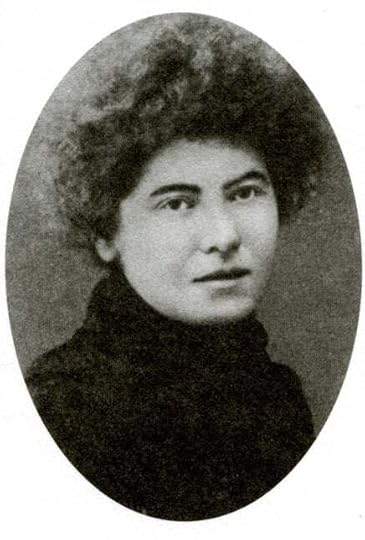
Jenny Laura Marx (also known as Laura Lafargue) was a German social activist, and a translator from German to French. Born in Brussels, Belgium, she was the second daughter of Karl Marx and Jenny von Westphalen, an activist and social critic in her own right. Laura moved with her parents to France, and then to Prussia, before the family settled in London in 1849.
Laura married French revolutionary socialist Paul Lafargue in 1868. They spent decades doing political work together, translating Karl Marx’s work into French, and spreading Marxism in France and Spain, while being financially supported by German philosopher Friedrich Engels.
Laura Marx died in 1911 in a suicide pact with her husband Paul Lafargue. She was 66, and he was 69. She left this letter, she wrote in part: “I die with the supreme joy of knowing that at some future time, the cause to which I have been devoted for forty-five years will triumph. Long live Communism! Long Live the international socialism!”
Laura Marx’s main translations were:
The Communist Manifesto (Manifeste du parti communiste, 1897) by Karl Marx and Friedrich EngelsRevolution and Counter-Revolution in Germany (Révolution et contre-révolution en Allemagne, 1900) by Karl MarxReligion, philosophie, socialisme (translated with Paul Lafargue, 1901) by Friedrich EngelsA Contribution to the Critique of Political Economy (Contribution à la critique de l’économie politique, 1909) by Karl Marx. . . . . . . . . .
Eleanor Marx,translator of Karl Marx’s works into English
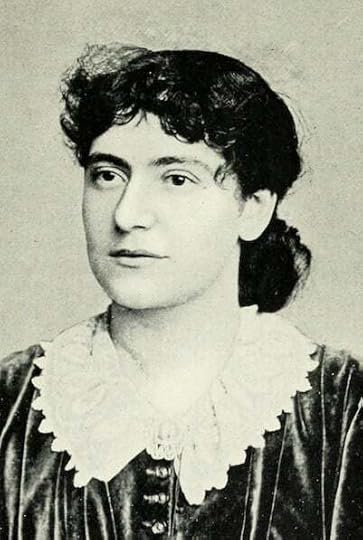
Eleanor Marx (1855-1898) was an English socialist activist and a translator from German, French and Norwegian to English. Known to her family as Tussy, she was the English-born youngest daughter Karl Marx and Jenny von Westphalen.
As a child, Eleanor Marx often played in in her father’s study while he was writing Capital (Das Kapital), the foundational text of what would become known as Marxism.
According to her biographer Rachel Holmes, “Tussy’s childhood intimacy with Marx whilst he wrote the first volume of Capital provided her with a thorough grounding in British economic, political and social history. Tussy and Capital grew together.” (quoted in Eleanor Marx: A Life, Bloomsbury, 2014).
Eleanor Marx became her father’s secretary at age sixteen and accompanied him to socialist conferences around the world.
In London, she met with French revolutionary socialist Prosper-Olivier Lissagaray, who had fled to England after participating in the Paris Commune, a revolutionary socialist government that briefly ruled Paris in 1871.
Eleanor Marx took her own life at age 43 after discovering that her partner, English Marxist Edward Aveling, had secretly married a young actress the previous year.
Translations of Karl Marx’s work
Eleanor translated some parts of Capital from German to English. She also edited the translations of Marx’s lectures Value, Price and Profit (Lohn, Preis und Profit) and Wage Labour and Capital (Lohnarbeit und Kapital) for them to be published into books.
After Karl Marx’s death in 1883, Eleanor Marx published her father’s unfinished manuscripts and the English edition of Capital (1887).
Other translations
Eleanor translated Lissagaray’s History of the Paris Commune of 1871 (L’Histoire de la Commune de 1871). The English edition was published in 1876. She also translated literary works, including French novelist Gustave Flaubert’s Madame Bovary in 1886.
Eleanor expressly learned Norwegian to translate Norwegian writer Henrik Ibsen’s plays, including An Enemy of the People (En Folkefiende) in 1888, and The Lady from the Sea (Fruen fra havet) in 1890.
. . . . . . . . . .
Source: A history of translation in 150 portraits
See also: 10 Lost Ladies of Literary Translation
Contributed by Marie Lebert. Reprinted by permission. Marie is a bilingual French-English translator. She has worked as a translator and/or librarian for international organizations and has written ebooks, articles and essays about translation and translators, ebooks, libraries and librarians, and medieval art. She holds a doctorate of linguistics (digital publishing) from the Sorbonne University, Paris, and a master of social science (society and culture) from the University of Caen, Normandy. Find more about women translators of the past at Marie Lebert.
The post Laura and Eleanor Marx, translators of Karl Marx appeared first on Literary Ladies Guide.
July 26, 2024
How to Burn a Book: Radclyffe Hall’s The Well of Loneliness
In a forthcoming book, I argue that 1928, when The Well of Loneliness (Radclyffe Hall) and Lady Chatterley’s Lover (D.H. Lawrence) were published, was the year in which sex and sexuality were first described openly in the novel without any authorial moral judgement.
So the passage below, from The Well of Loneliness, would not have been a problem in 1928 if Stephen Gordon had been a man; but Stephen is a woman.
But her eyes would look cold, though her voice might be gentle, and her hand when it fondled would be tentative, unwilling. The hand would be making an effort to fondle, and Stephen would be conscious of that effort. Then looking up at the calm, lovely face, Stephen would be filled with a sudden contrition, with a sudden deep sense of her own shortcomings; she would long to blurt all this out to her mother, yet would stand there tongue-tied, saying nothing at all. (Radclyffe Hall, The Well of Loneliness, 1928)
By 1928 it was accepted that women in novels should have a sexual life – younger women and older women, women married and unmarried, modern women and flappers.
A sexual relationship in the 1928 novel could be inside or outside marriage, with the woman as an adulteress or as a single woman with an adulterous man. The novels of 1928 mostly did not judge. Fidelity was no longer considered a necessary virtue for women, just as it had never been for men; 1928 saw women in Great Britain get equal voting rights to men and novelists gave them equal sexual rights to match.
The only caveat was that a woman’s sexual life should not involve other women, though even then the serious literary critic was prepared to accept such a serious treatment of such a serious subject as Radclyffe Hall’s, especially if it made being gay (in the contemporary sense) seem the opposite of gay (in the 1928 sense), as it certainly did.
No one in The Well of Loneliness is having any fun and lesbianism is made to seem very gloomy indeed. Surely no bi-curious adolescent has ever been converted to the Sapphic cause by reading it.
The Well of Loneliness is often regarded as the first lesbian novel though this is an assertion which I have tried to refute elsewhere.
. . . . . . . . . .
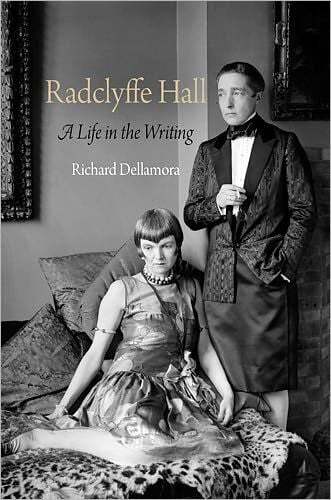
. . . . . . . . . .
Positive early reviewsRadclyffe Hall’s fifth published novel, The Well of Loneliness was released as a very high-priced hardback in 1928 and treated with the same polite earnestness by the erudite reviewers in the heavyweight British literary magazines and newspapers as her previous four. All had received mostly respectful but unenthusiastic reviews in the “serious” press.
Hall and her partner Una Troubridge were well-known and accepted on the British literary and social scene despite always cross-dressing in a very provocative manner. Because of its high price, the novel was expected only to sell to these cognoscenti: educated, progressive people who would not be expected to be upset by its lesbian subject matter.
The early reviewers mostly treated it as a literary, even a philosophical work, rather than a provocatively sexual one – not that there is any sex in The Well of Loneliness. There is a sympathetic forward by the prominent sexologist Havelock Ellis.
Here are a couple of positive early, published before a sensational article in a tabloid newspaper stirred up a public outrage.
Miss Radclyffe Hall’s latest work, The Well of Loneliness (Cape, 15s. net) is a novel, and we propose to treat it as such. We therefore rather regret that it should have been thought necessary to insert at the beginning a “commentary” by Mr. Havelock Ellis to the effect that, apart from its qualities as a novel, it “possesses a notable psychological and sociological significance” as a presentation, in a completely faithful and uncompromising form, of a particular aspect of sexual life to the book as a work of art this testimony adds nothing; on the other hand, the documentary significance of a work of fiction seems to us small.
The presence of this commentary, however, points to the criticism which, with all our admiration for much of the detail, we feel compelled to express – namely, that this long novel, sincere, courageous, high-minded, and often beautifully expressed as it is, fails as a work of art through divided purpose. It is meant as a thesis and a challenge as well as an artistic creation. (Times Literary Supplement, August 2, 1928)
. . . . . . . . . .
The Well of Loneliness by Radclyffe Hall, is a very difficult work to review. Should I praise it, then I can literally hear the huge army of the narrow-minded hinting that I am in sympathy with its publication.
Should, on the other hand, I dismiss it as a novel written on a subject which is unmentionable, then I should condemn a work of considerable art; a story which is poignantly tragic to a degree; one of the few books I have ever read which illustrates the pitiful loneliness of sexual perversity as it is, apart from the pervert’s psychological and biological significance.
Every work of art, every undertaking designed in all seriousness, must, however, be viewed objectively. One may have little or no sympathy with the subject – but that is not the point. Criticism should not be prejudice disguised as erudition, though only too often it is thus bedecked. In any case, only the bigoted and the foolish seek to ignore an aspect of life which is as undeniable a fact as any concrete thing. To deny something because you dislike to confess that it is true belongs to the mentality of the undeveloped. (Richard King, The Tatler, August 15, 1928)
. . . . . . . . . .
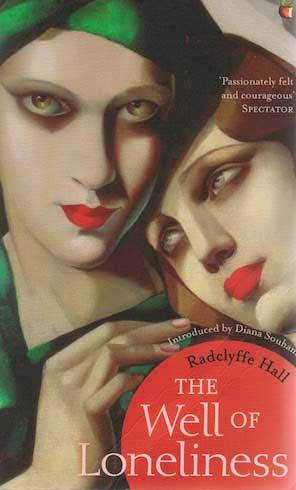
Quotes from The Well of Loneliness
. . . . . . . . . .
On August 19, 1928, the editor of the British tabloid paper The Sunday Express published a hysterical article entitled “The Book That Must be Suppressed” accompanied by a picture of Hall with her severe haircut, then called an Eton crop, dressed in a very masculine black smoking jacket with bow tie, holding a cigarette and looking out disdainfully.
Almost all press photographs of Hall from the time show her apparently wearing a man’s suit; in fact she nearly always wore a bespoke, tailored, knee-length skirt rather than trousers to match the tailored jacket but photos hardly ever showed below the knee.
In the Express article, the editor states that, “So far as I know, it is the first English novel which presents, in a completely faithful and uncompromising form, one particular aspect of sexual life as it exists among us today.”
The editor notes that the book is intended to present the lives of its characters sympathetically in order that they may be understood.
But he is not convinced. “This is the defence and the justification of what I regard as an intolerable outrage – the first outrage of this kind in the annals of English fiction.” The editor also says that artistic merit is no defense; quite the reverse in fact.
The adroitness and cleverness of the book intensifies its moral danger. It is a seductive and insidious piece of special pleading designed to display perverted decadence as a martyrdom inflicted upon these outcasts by a cruel society. It flings a veil of sentiment over their depravity. It even suggests that their self-made debasement is unavoidable, because they cannot save themselves.
In the most infamous quote in the article, the editor says, “I would rather give a healthy boy or a healthy girl a phial of prussic acid than this novel. Poison kills the body, but moral poison kills the soul. . . The book must at once be withdrawn.”
. . . . . . . . . .
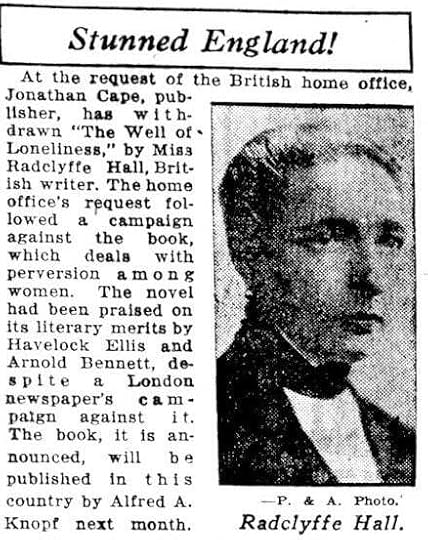
. . . . . . . . . .
Rebuttal to the negative reviewsAt least one serious British newspaper returned fire to the growing number of negative reviews, including this article titled “The Stunters and the Stunted.”
Will stunt journalism be allowed to cripple and degrade English literature? The question is raised by an article in a Sunday newspaper clamouring for the suppression of a novel, The Well of Loneliness, written by Miss Radclyffe Hall and published by Messrs. Jonathan Cape, Ltd, price 15s.
The book is the story of an abnormal woman. It is a restrained and serious psychological study. It is written “with understanding and practice, with sympathy and feeling,” says The Nation. It is “sincere, courageous, high-minded and often beautifully expressed,” says The Times Literary Supplement.
But the stunt journalist, writing for a Sunday newspaper which revels in the revelations of murderers and in the views and confessions of the unfortunate persons made notorious by the terrible ordeal of trial for murder, can see here an opportunity for sensation-mongering . . .
In this book there is nothing pornographic. The evil-minded will seek in vain in these pages for any stimulant to sexual excitement. The lustful sheikhs and cavemen and vamps of popular fiction may continue their sadistic course unchecked in those pornographic novels which are sold by the millions, but Miss Radclyffe Hall has entirely ignored these crude and violent figures of sexual melodrama. She has given to English literature a profound and moving study of a profound and moving problem. (Arnold Dawson, The Daily Herald, August 20, 1928)
The British Establishment very quickly came down on the side of the tabloids; the British publishers offered to withdraw it just a few days later in a letter to The Times – knowing, however, that they could quickly reprint it in France and sell it there without fear of censorship.
Sir, – We have today received a request from the Home Secretary asking us to discontinue publication of Miss Radclyffe Hall’s novel: “The Well of Loneliness.” We have already expressed our readiness to fall in with the wishes of the Home Office in this matter, and we have therefore stopped publication.
I have the honour to be your obedient servant,
Jonathan Cape (for and on behalf of Jonathan Cape, Ltd), August 23, 1928
Just a few days later, another British tabloid newspaper, The People, also jumped on the censorship bandwagon, claiming that it was them who had originally asked for a ban of this “revolting” book.
The “secret novel” to which “The People” drew attention last week has been withdrawn by the publishers at the request of the Home Secretary.
While other newspapers were trying to make up their minds about the book, “The People” had already decided that the revolting aspect of modern life with which it dealt made its publication undesirable.
Further, “The People” announced exclusively, a week ago, that the novel, and the banning of it, were under official consideration.
The Home Secretary’s acceded request for the books withdrawal is a triumphant vindication of “The People’s” judgement. (The People, August 26, 1928)
Banning and, in the case of The Well of Loneliness, literally burning copies of a book is always a great way to increase sales, as the writer of a letter to another newspaper very quickly found.
I happened to visit two well-known London bookshops today, and I had not been in either five minutes before I heard mention made of Miss Radclyffe Hall’s suppressed book.
In one shop a customer enquired whether a copy could still be obtained through the circulating library department, and was told that the probable policy of the library would be to withdraw all copies in circulation as soon as they were returned, and issue no more.
In the other shop a customer was expressing at some length to an assistant his views on the unfairness, not so much of the suppression, as of the methods adopted to bring it about. (Yorkshire Post, August 28, 1928)
Nevertheless, even some of the more serious, upmarket British journals also jumped swiftly onto the ban-the-book bandwagon, including The Tatler which only two weeks earlier had reviewed The Well of Loneliness fairly and sympathetically.
The Home Secretary is to be congratulated on having secured the suppression of “The Well of Loneliness” without setting the Public Prosecutor in action. The book is mischievous and unwholesome; but a prosecution would certainly have failed, because there is not an indecent word or an obscene image in it from the first to the last page.
The police authorities are well aware that prosecutions for sexual abnormality, even when a conviction is obtained, do more harm than good, and always, if they can, avoid proceedings . . . The female “invert,” up to now regarded as a hysterical half-wit, is by Miss Radclyffe Hall described as the victim of a pre-disposition or pre-natal taint.
Possibly, but is not the same true of the male invert? Happily the question has been settled by the good taste and common sense of Messrs. Cape, who agreed at once to withdraw the book. (The Tatler, September 5, 1928)
The Home Secretary in question was the aristocratic Sir William Joynson-Hicks, Viscount Bedford, who had been described as “the most prudish, puritanical and protestant Home Secretary of the twentieth century.” Jix, as he was known, was loved by the tabloid press but treated as a laughing stock by the serious journals.
As Home Secretary he cracked down on many aspects of the Roaring Twenties of which he disapproved, including the existence of London nightclubs, many of which he ordered the Metropolitan police to raid. Hicks said he was trying to stem “the flood of filth coming across the Channel,” banning the works of D. H. Lawrence whose Lady Chatterley’s Lover was published privately in 1928 in Italy partly because of him – Jix forced the publishers to issue an expurgated version in Britain.
He also clamped down on books on birth control and a translation of Boccaccio’s admittedly raunchy The Decameron which nevertheless dates from the 1350s. Hicks even opposed the revision of The Church of England’s Book of Common Prayer in his own book The Prayer Book Crisis, published in May 1928.
However, despite his disapproval of the “modern woman,” Hicks did personally drive through Parliament the Equal Franchise Act of 1928 which gave women equal voting rights to men – rights they unhesitatingly used to unseat Hicks’ own Conservative party in the General Election of the following year.
Fellow writers try to appeal to reason
Fellow writers generally agreed that books should not be banned because of their subject matter. British novelist E. M. Delafield (whose 1928 novel What is Love? has contrasting heroines in Vicky and Ellie who are reminiscent of Vanity Fair’s Becky and Amelia but with more of a sex life) gave a talk to a woman’s group in Leeds while the controversy was raging in which she directly addressed the issue.
Virginia Woolf, whose pansexual novel Orlando was also published in 1928, was tepid about The Well of Loneliness, though it was the literary style she disapproved of rather than the content. She wrote in a letter, “At this moment our thoughts centre upon Sapphism. We have to uphold the morality of that Well of all that’s stagnant and lukewarm and neither one thing or the other; The Well of Loneliness.”
And in another letter, “The dulness [sic] of the book is such that any indecency may lurk there — one simply can’t keep one’s eyes on the page.” She also wrote in her diary about the publisher’s appeal in court of “The pale tepid vapid book which lay damp and slab all about the court.”
However, she and E. M. Forster attended the appeal together and wrote a letter to The Nation in support.
The Well of Loneliness is restrained and perfectly decent, and the treatment of its theme is unexceptionable. It has obviously been suppressed because of the theme itself. May we add a few words on this point?
The subject-matter of the book exists as a fact among the many other facts of life. It is recognised by science and recognisable in history. It forms, of course, an extremely small fraction of the sum-total of human emotions, it enters personally into very few lives, and is uninteresting or repellent to the majority; nevertheless it exists, and novelists in England have now been forbidden to mention it by Sir W. Joynson-Hicks.
May they mention it incidentally? Although it is forbidden as a main theme, may it be alluded to, or ascribed to subsidiary characters? Perhaps the Home Secretary will issue further orders on this point.
Seizure of and destruction of printed copies proceeds
Despite the support of well-known writers, the publisher’s appeal against the seizure of two hundred and forty seven copies of the book and the decision to destroy them failed; the appeal judge made no attempt to hide his prejudice, as reported in another tabloid newspaper.
In giving the decision of the Court, Sir Robert Wallace said there were plenty of people who would not be depraved or corrupted by reading this book, but there were also those whose minds were open to such immoral influences.
The view of this Court is that this book is very subtle, insinuating in the theme it propounds, and much more dangerous because of that fact.
It is the view of this Court that this is a most dangerous and corrupting book . . . that it is a disgusting book, a book which is prejudicial to the morals of the community, and in our view the order made by the magistrate was a fair one, and the appeal is dismissed with costs. (Daily Mirror, December 15, 1928)
After the appeal court decision, the seized copies of the novel were very quickly burned “in the King’s furnace” – five years before the first fascist book burnings in Germany – a notorious occasion reported, mostly approvingly, in the popular press.
All the seized copies of Miss Radclyffe Hall’s novel, “The Well of Loneliness,” will early this week help to warm the many rooms of New Scotland Yard.
It is understood that the copies of the book, which are now under lock and key, will be fed into the furnaces in the basement of New Scotland Yard and be destroyed. The destruction of the books will be conducted under the supervision of at least one officer of high rank. (Aberdeen Press and Journal, December 17, 1928)
. . . . . . . . . . .
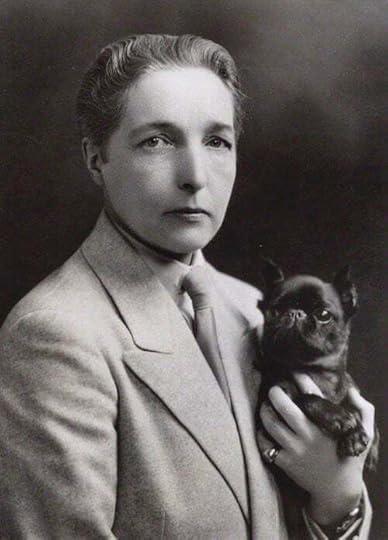
More about Radclyffe Hall
(photo, ca 1930, courtesy of Wikimedia Commons)
. . . . . . . . . . .
Meanwhile, The Well of Loneliness had swiftly been reprinted in Paris and was openly and very successfully on sale there, as attested by a couple of sympathetic female journalists, including the Paris correspondent of the very Tatler which had just the week earlier condemned the book.
At my flat in Paris I found a copy of Radclyffe Hall’s “Well of Loneliness” and, incidentally, many thanks to the sender whose handwriting on the address I did not recognise! I read it from cover to cover with breathless interest, and very soon, no doubt, I shall read it again.
Rarely has Paris “been so well done,” and not only the pages referring to a certain Paris and a certain milieu of that certain Paris, but the whole atmosphere of my beloved city. I am told that this novel has started a certain amount of yapping, and this seems curious to me, for I have read several notices of it in the columns of such “pillars of the Press” as “The Sunday Times,” “The Morning Post,” “The Saturday Review,” and “The Telegraph,” which were, in most cases, understanding and appreciative.
Strange the difficulty that some people have to keep calm when any pitiful aspect of sexual life is discussed. Pitiful? Why, of course. No one deliberately wants to be uncomfortable, and anything abnormal is dashed uncomfy. (“Priscilla in Paris,” The Tatler, September 12, 1928)
And early the next year the Paris correspondent of the prestigious New Yorker, a journalist and novelist – and lesbian – herself, reported that the novel was openly on sale and highly popular there.
It may be interesting to know that Radclyffe Hall’s novel about Lesbians, The Well of Loneliness, though banned in England and under fire in New York, has escaped condemnation in France, where it now enjoys a local printing. Its biggest daily sale takes place from the news vendor’s cart serving the deluxe train for London, La Flèche d’Or, at the Garde du Nord.
The price is one hundred and twenty-five francs a copy. For first English editions, dealers in the Rue de Castiglione offered to buy for as high as six thousand francs, and to sell at as high as anything you are silly enough to pay. (Janet Flanner, ‘Letter from Paris,’ New Yorker, 1929)
In Flanner’s native New York however things did not go so well for the Well, as reported in the New York Times for February 22, 1929.
Magistrate Hyman Bushel in the Tombs Court ruled yesterday that the book “The Well of Loneliness” by the Englishwoman writer Radclyffe Hall is obscene and was printed and distributed in this city in violation of the penal law. He ordered a complaint drawn against the Covici, Friede Corporation, American publishers of the book . . .
Mr. Friede, who was in court when the decision was announced, was promptly arrested, but freed in $500 bail, which he furnished in cash. No bail was fixed in the case of the corporation. Hearings were held several weeks ago by the magistrate in the West Side Court in a proceeding started by John S. Simner, superintendent of the Society for the Suppression of Vice, who had seized 855 copies of the novel at the publisher’s office.
Friede had gambled big by taking out a huge $10,000 dollar loan to buy the US publication rights from Cape in England but he could still easily afford to pay the $500 bail, which he probably did with a triumphant smile, since he had already sold 100,000 copies of the paperback at $5 each – double the normal price of a paperback novel at the time.
As Una Troubridge said, “What nobody foresaw was that the re-publication in Paris would be followed by translation into eleven languages, by the triumph of the book in the United States of America and the sale of more than a million copies.” Censorship works in the short run, but rarely in the censor’s favor.
Contributed by Francis Booth, the author of several books on twentieth-century culture: Amongst Those Left: The British Experimental Novel 1940-1960 (published by Dalkey Archive); Everybody I Can Think of Ever: Meetings That Made the Avant-Garde; Girls in Bloom: Coming of Age in the Mid-Twentieth Century Woman’s Novel; Text Acts: Twentieth-Century Literary Eroticism; Comrades in Art: Revolutionary Art in America 1926-1938; High Collars & Monocles: 1920s Novels by British Female Couples; and A Girl Named Vera Can Never Tell a Lie: The Fiction of Vera Caspary.
Francis has also published several novels: The Code 17 series, set in the Swinging London of the 1960s and featuring aristocratic spy Lady Laura Summers; Young adult fantasy series The Watchers; and Young Adult fantasy novel Mirror Mirror. Francis lives on the South Coast of England.
The post How to Burn a Book: Radclyffe Hall’s The Well of Loneliness appeared first on Literary Ladies Guide.
July 25, 2024
Ban if You Can: Banning & Censorship in Contemporary India
India’s celebrated diversity and, by and large, a sense of peaceful co-existence has taken a severe hit since the past decade. This has been linked with the rise of right-wing Hindutva in politics, which has bred a sense of injured pride in the Hindu majority accompanied by a phobia created about the threat from minorities, most of all Islam.
The myths being perpetrated include the uncontrolled rise in the Muslim population, as also the physical threats that could result from this change in demographics.
There is no data to substantiate these claims but with the power of social media and its ability to make a piece of fake news viral, nobody seems to care anymore to do a fact check and most people are quite content to believe all the lies that land on their telephones, day in and day out.
At such a juncture, all forms of media including books, have the power to influence people and change minds. Hence, governments and powerful religious groups are very sensitive about certain topics, which they feel the public should be denied access to. With this started the history of bans in India, though it is not as if other more progressive countries have not done their share of banning.
Book banning in IndiaAubrey Menen and Salman Rushdie
One of the earliest books to be banned in India was Rama Retold. Written in 1954 by the British writer Aubrey Menen as a spoof with a dose of humor, it clearly did not appeal to the funny bone of Indians and the book was prevented from being imported into India.
The author, labeled as a satirist, novelist and theatre critic, was probably much more, as he took pot shots at all the characters in the Ramayana, including the one who is said to have authored the Ramayana, Valmiki.
In today’s India, this retelling might have brought him death threats and though he chose to make India his home in later life, he fortunately didn’t live to see this phase of India’s authoritarian grip on the written and spoken word.
Sometimes, as it happened with Salman Rushdie’s Satanic Verses, it is the fear of communal conflagrations that can result in a ban. Even though the book made it to the Booker shortlist, the government headed by the Congress party under Rajiv Gandhi, decided to play safe and enforce a ban on the book.
In 1989, there was a fatwa put on Rushdie by Ayatollah Khomeini of Iran and the author had to go into hiding for long years. It is tragic how Rushdie nearly paid with his life in August 2022, despite years having gone by, since the fatwa was lifted.
One is not sure whether the misguided assailant had even read the book. Rushdie’s cup of woes did not end with the Satanic Verses in India.
His Moor’s Last Sigh, also came in for criticism and protests in the state of Maharashtra, as one of the characters seemed to bear a resemblance to Balasaheb Thackeray, the founder of a political party called the Shiva Sena. That Thackeray started his career as a journalist, makes this all the more ironic.
Dan Brown
When it came to Dan Brown’sThe Da Vinci Code, it was India’s Christian population that rose up in protest claiming that the book had made profane statements on Christ.
Despite selling millions of copies worldwide, after the movie version was released in 2006, the book was prevented from being “sold, distributed and read.” The movie also came in for a ban in several states of India, where the Christian population were located in large numbers.
Arundhati Roy
In a country steeped in patriarchy, many women authors have had to face criticism of their books, if not outright bans. Arundhati Roy, who won the Booker Prize for her God of Small Things, had to fight a case, as a lawyer in Kerala was offended by her book with its reference to an upper caste Kerala woman cohabiting with a man from a lower caste.
But truth is stranger than fiction. Even today the papers are full of stories of families attacking couples belonging to different castes, with some of them ending in the tragic death of one or both.
Indian patriarchy strangely extends across the different religions that have incubated here. At the heart of this sense of ownership of a woman is likely linked to an ancient lawmaker, Manu, who in his Manusmriti, has clearly spoken of a woman as a piece of property and drawn the most demeaning parallels about her position in society.
That the present Union government is trying to bring in the Manusmriti as a part of its newly amended criminal laws, has led to a lot of protests, including from those of the legal fraternity. If Manu’s code is revived by this government, it will certainly be back to the dark ages for the women of India, especially those who live in the villages and small towns, with less access to education and an already internalized acceptance of patriarchy.
. . . . . . . . . .
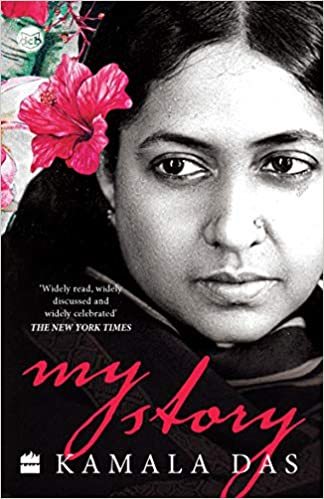
. . . . . . . . . .
Kamala Das
Another woman author who had to face a great deal of censure was the Malayalam author, Kamala Das, who wrote fearlessly about a woman’s body and its needs.
Her writings shook society and Das had to face a huge backlash from an orthodox society. But she was unfazed and continued writing till her last breath. Even today, her writings make up a big part of feminist Indian writing.
Poet, author, social scientist and feminist Kamla Bhasin put it succinctly when she observed, “My honour is not in my vagina.” The tragedy of patriarchy is in its belief that this is where a woman’s honor vests.
In recent times, the politics surrounding food have also led to the banning of movies, including those available for live streaming. While propaganda films have managed to garner awards in the last ten years, the right-wing ecosystem seems to exercise strict control about what films are suitable for viewing by the Indian public.
A contemporary film bannedIt’s enough for just one person to see a movie, feel outraged by it and have it banned by posting about it on social media. One such film, which was removed from Netflix was Annapoorani: The Goddess of Food. The furor over “hurting Hindu religious sentiment,” resulted in its removal at its “licensor’s request.”
The gist of the story revolves around actor, Nayanthara, aspiring to become a cook by learning to eat and prepare non-vegetarian dishes, which are taboo in a Brahmin home. It’s another story that many Indians from the upper castes have broken this taboo, but of course this is again a question of patriarchy rearing its head in that a woman does not have a right over her food choices either.
The role of India’s government in banning and censorshipIn earlier times, governments banned books or movies in anticipation of trouble, or because they felt jittery over certain allusions in books and the popular media.
Today the government has managed a huge stranglehold on the dissemination of information. The mainstream media has largely become a propaganda machine for the government and has earned for itself the title of Godi or Lap Media.
Many activists find themselves in jail over trumped up charges of spreading fake news. The independent media is always up for censure with several journalists feeling threatened about how they cover news. Even stand-up comics have not been spared, with many of their shows being called off because someone protested during the event, or prior to the staging.
The author Aubrey Menen, mentioned earlier, put it best in his closing lines of Rama Retold, which he reserved for his favorite character, Valmiki:
“There are three things, which are real: God, human folly and laughter. Since the first two pass our comprehension, we must do what we can with the third.”
It is sad that Indians seem to have missed out on the joys of laughing at their own foibles because at the end of the day, it is just the fact of having a very thin skin, especially our politicians.
Contributed by Melanie P. Kumar: Melanie is a Bangalore, India-based independent writer who has always been fascinated with the magic of words. Links to some of her pieces can be found at gonewiththewindwithmelanie.wordpress.com.
The post Ban if You Can: Banning & Censorship in Contemporary India appeared first on Literary Ladies Guide.
July 22, 2024
But Gentlemen Marry Brunettes, the sequel to Gentlemen Prefer Blondes
Anita Loos’ wildly successful 1925 novel Gentlemen Prefer Blondes was followed by a sequel, But Gentlemen Marry Brunettes. Published in the U.S. in 1927 and in England in 1928, it continued the adventures of the free, independent but ditzy Lorelei Lee and her friend, Dorothy Shaw.
Despite her misspellings and malapropisms, Lorelei is very much the modern, free 1920s woman and though she is deliberately written to appear as a “dumb blonde,” she is actually extremely sharp (and beautifully written in a virtuoso performance by Loos).
Lorelei wants us to understand that she is not a gold digger but a “diamond collector” and her faux-naïve monologue – the novel purports to be Lorelei’s diary – contains many other gems that sound in retrospect as though they were written specifically for Marilyn Monroe, even though Monroe was only two years old when the novel was published:
“Diamonds are a girl’s best friend.”“Money may not buy happiness, but it sure does make it easier to be glamorous.”“Being blond means never having to say sorry for being fabulous.”Not that Lorelei intends to be dependent on a man —“Why chase after a man when you can chase after a job and have both?” And, as she says, “success is the best revenge, especially when you’re wearing a stunning dress.”
The famous 1953 film adaptation of Gentlemen Prefer Blondes, starring Marilyn Monroe and Jane Russell, bears only passing resemblance to the original book, and 1955’s Gentlemen Marry Brunettes film, starring Jane Russell and Jeanne Crain as Dorothy Shaw’s daughters, even less so.
. . . . . . . . . .
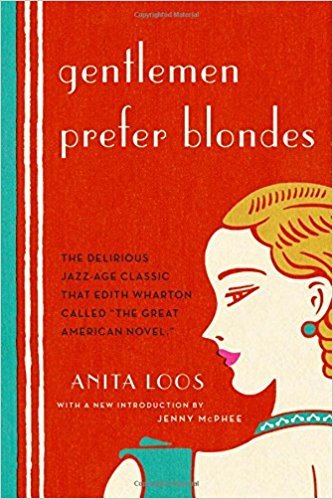
Gentlemen Prefer Blondes (1925 novel)
by Anita Loos
. . . . . . . . . .
Like the best of modern 1920s women, Lorelei doesn’t need to be saved, she just needs a man to spend his savings on her. “I don’t need a knight in shining armor, I need a man who can keep up with me.”
And: “I refuse to be just another pretty face. I’m here to own the room and conquer the world.”
There is also a quote in the original novel that gives the clue to the incomplete nature of the book’s title, “Gentlemen may prefer blondes, but smart men prefer a blonde with a brain.”
At the beginning of this sequel, Lorelei tells us that she is “going to begin a diary again, because I have quite a little time on my hands.” The new diary, like the one in the previous novel, is full of the delightful non-standard spellings and howlers as the first one – Loos’ technical skill is severely underrated in my opinion.
In the new diary, Lorelei’s foil Dorothy is back as her sounding board. “I mean sometimes Dorothy becomes Philosophical, and says something that really makes a girl wonder how anyone who can make such a Philosophical remark can waste her time like Dorothy does.”
. . . . . . . . . .
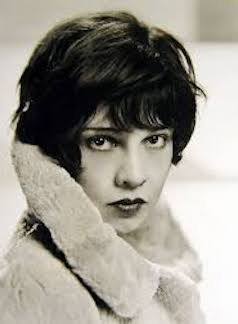
More about Anita Loos
. . . . . . . . . .
Now married to Henry, who is of “the wealthy classes,” Lorelei says that “practically every married girl ought to have a career if she is wealthy enough to have the home life carried on by the servants.” And especially, as in her case, if she is married to husband like Henry, who is “quite a homebody and, if the girl was a homebody to, she would encounter him quite often.” So
Lorelei tells her diary that she needs to get out of the house and “to meet brainy gentlemen who have got ideas on the outside.”
The first career Lorelei tries is the cinema, where she stars in “a superproduction based on sex life in the period of Dolly Madison” [wife of James Madison, fourth president of the United States at the beginning of the 1800s].
The production team argue as to whether it should be full of “Psychology,” mob scenes and ornamental sets or full of a “great moral lesson,” as Henry wants. “I did not care what it was full of, as long as it was full of plenty of cute scenes where the leading man would chase me round the trunk of a tree and I would peek out at him, like Lillian Gish.”
Well, when our cinema was finished the title turned out to be “Stronger than Sex,” which was thought up by quite a bright girl in Mister Goldmark’s suite of offices. And the great moral lesson was, that girls could always help it, if they would only think of Mother.
Lorelei has a baby
But Lorelei becomes pregnant and has to give up her career in the cinema. Dorothy says that “a kid that looks like any rich father is as good as money in the bank,” and Lorelei is happy to be pregnant so soon after the marriage because “the sooner a girl becomes a Mother after the ceremony, the more likely it is to look like Daddy.”
Dorothy advises her however to only have one “kiddie” because she thinks that “one is enough of almost anything that looks like Henry. But Dorothy has no reverents for Motherhood.”
Henry wants to stay in Philadelphia to have the baby because, as Lorelei says, in Philadelphia he is quite “promanent,” whereas Lorelei is desperate to move to New York, even knowing that “the riskay things that Henry can think up may intreege the suberbs of Philadelphia, but they really would not be such a thrill in New York.”
She asks a New York friend, who is “very, very promanent” to get invitations for Henry to join various societies. It works; “when Henry started in to receive all of those invitations, it made him feel very good to think that his promanents had reached New York.”
She decides to “become literary”After the baby comes, Henry settles “quite a large settlement on me.” But Lorelei is bored and soon starts to think of a new career. “I decided not to produce any more cinemas, because ‘Stronger Than Sex’ went right over people’s heads and became a financial failure. So I decided to become literary instead and spend more time in some literary envirament, outside the home.”
Lorelei starts with probably the most literary environment in New York, the Algonquin Hotel, still the real-life home in 1928 to Dorothy Parker and the Vicious Circle; she goes for lunch and charms the waiter into sitting them next to the famous writers.
After Dorothy gets bored and leaves, Lorelei is invited to sit at the table of “all the geniuses” by one of them, who says to his companions, “you are always discovering a Duse, or a Sapho or a Cleopatra every week, and I think it is my turn. Because I have discovered a young lady who is all three rolled into one.”
Lorelei has already said of this man that he “is always falling in love with some new girl” so she is not surprised when he says he has “noted my reverants for everything they said and he finally told me that he realised I had more in me than I looked, so he issued me an invitation to come to luncheon every day.”
But Lorelei has already decided to join another organization, the Lucy Stone League – a real-life women’s establishment founded in 1921 that advocated women keeping their name after marriage. Lorelei wants to be able to “write my book without my identity being sunk by having the name of a husband to crush me.”
Because a girl’s name should be Sacred, and when she uses her husband’s it only sinks her identity. And when a girl always insists on her own maiden name, with vialents, it lets people know that she must be important some place or other.
And quite a good place to insist on an unmarried name, is when you go to some strange hotel accompanied by a husband. Because when the room clerck notes that a girl with a maiden name is in the same room with a gentleman, it starts quite a little explanation, and makes a girl feel quite promanent before everybody in the lobby.
But Dorothy said I had better be careful. I mean she says that most Lucy Stoners do not really worry the room clerck, because they are generally the type that are only brought to hotels on account of matrimony.
But Dorothy said that when Henry and I waltz in and ask for a room with my maiden name the clerck would probably get one good look at me, and hand Henry a room in the local jail for the Man act [the Mann Act of 1910 criminalized the transportation of “any woman or girl for the purpose of prostitution or debauchery, or for any other immoral purpose”].
“I do not listen to any advice about literature from a girl like Dorothy. And so I joined it.”
Lorelei’s novel and Dorothy’s misadventures
Lorelei decides to write her novel about Dorothy, which “is not going to be so much for girls to resemble, as it is to give them a warning what they should stop doing.” Dorothy turns out to have had a very interesting childhood, starting from “quite a low enviranment,” and though she has improved herself to the extent of living at the Ritz, Dorothy still “does nothing but fall madly in love with the kind of gentlemen who were born without money and have not made any since.”
By the age of sixteen Dorothy has ended up working among grifters and tricksters in a “Carnaval Company” but still seems to be a virgin, “without the subjeck of ‘Life’ being brought to turn notice. Because when I was only 13, I sang in our church quire, and practically every boy in our quire had at least mentioned the subjeck and some of them had done even more.”
Lorelei’s reasoning for this is that in a Carnaval Company “nothing is Sacred,” and people can make jokes about matters of Life. “But Love is so Sacred in a church quire, that they never even mention it above a whisper, and it becomes more of a mistery. And when a thing is a mistery, it is always more intrieging.”
So for Lorelei growing up there was ironically “quite a lot more Love going on” than in Dorothy’s traveling circus.
Eventually, Dorothy has come to the conclusion that it is time that she gave the “love racket” a whirl, “and find out for herself if it had really been over-advertised.” Her skepticism is not surprising to Lorelei, given that she lives in the company of people whose whole lives involve swindling the public. But when Dorothy “decided to do it,” and “find out about ‘Things,’” the only person she could think of who might be interested is the “Deputy Sherif” so she gives him “a kind word.”
After going with him to the cinema, Dorothy decides to let the Deputy Sherif kiss her, Dorothy’s first kiss. It is a big disappointment. “Dorothy says she felt like a little boy who had just found out that Santy Clause was the Sunday School Superintendant.”
Dorothy passes up the chance to marry into the Deputy Sherif’s wealthy family and runs away to join an acting company run by a Frederik Morgan, having decided on her new career after seeing Morgan playing the lead in “The Tail of Two Cities,” after which “the whole subjeck of Sex Appeal had taken on quite a new aspeck to Dorothy. And Dorothy says she decided that all of the things the Deputy Sherif had tried on her, that only made her squirm, would be a Horse of a different color with that leading man in the role.”
So Dorothy accompanies Mr Morgan up to his apartment where he tells her the story of “his Life,” which includes the fact that he has a wife but had to send her away because “an Artist must use all of his feelings to develop his temprament by.”
And then he told Dorothy that she would probably turn out to be an Artist herself, as soon as she got her temprament developed and found out about Life.
And he said that he himself would be willing to teach her about Life and give her all his ade. And he told her it was really quite a large opertunity for a girl like her, when society women with strings of pearls were after it. So after he finished his recomendation, he asked Dorothy whether she would like to go home, or take off her things and stay awhile.
So Dorothy took off her things.
But it turns out that learning about Life does not improve Dorothy’s acting “temperament” and, worse, it “did not turn out to be so enjoyable to her, after all. I mean, Dorothy is never at her best in a tate-a-tate.”
Both parties agree to “let the matter drop,” but Dorothy continues to act and then gets a job at the Follies, where she impresses a millionaire polo player, Charlie Breene. But the rich boy bores her and she gives him the slip. “And Dorothy says that running out on millionaires has been her specialty ever since.”
So, despite impressing the polo player’s millionaire society mother, Dorothy runs off with a “saxaphone player” she met at the Follies. The marriage goes wrong for Dorothy on the way to the wedding, when she sees her future husband Lester in the daylight for the first time and is not impressed; she spends the next several chapters trying to get away from him, with the ostensible help of the Breene family’s money and lawyer, during which Dorothy goes on a trip to Paris.
The polo player’s family money had actually been secretly supporting Lester and when the money stops, he blackmails the Breenes’ lawyer into paying him $10,000 to go away. The upshot is that Dorothy is now free to marry Charlie so her worried family pay the lawyer to frame her on a drugs charge and the police lock her up.
But Lorelei comes to her rescue and then Charlie reappears, having been cut off from his family’s money and got himself sober. Dorothy falls in love and, reader, she married him.
. . . . . . . . . . .
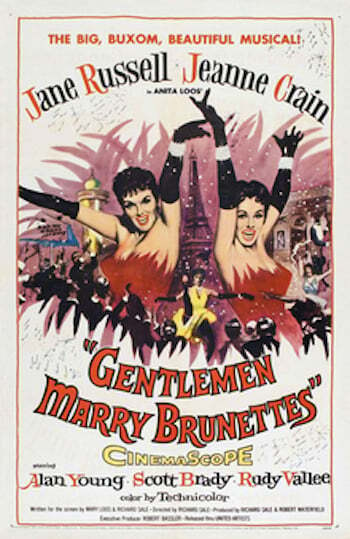
The 1955 film, Gentlemen Marry Brunettes,
has little in common with the 1927 original novel
. . . . . . . . . .
Contributed by Francis Booth, the author of several books on twentieth-century culture: Amongst Those Left: The British Experimental Novel 1940-1960 (published by Dalkey Archive); Everybody I Can Think of Ever: Meetings That Made the Avant-Garde; Girls in Bloom: Coming of Age in the Mid-Twentieth Century Woman’s Novel; Text Acts: Twentieth-Century Literary Eroticism; Comrades in Art: Revolutionary Art in America 1926-1938; High Collars & Monocles: 1920s Novels by British Female Couples; and A Girl Named Vera Can Never Tell a Lie: The Fiction of Vera Caspary.
Francis has also published several novels: The Code 17 series, set in the Swinging London of the 1960s and featuring aristocratic spy Lady Laura Summers; Young adult fantasy series The Watchers; and Young Adult fantasy novel Mirror Mirror. Francis lives on the South Coast of England.
The post But Gentlemen Marry Brunettes, the sequel to Gentlemen Prefer Blondes appeared first on Literary Ladies Guide.
July 21, 2024
65 Witty, Bawdy Mae West Quotes
Mae West (1893 – 1980) earned international fame as an actress and singer, but she was also a talented playwright and screenwriter. In fact, it was she who wrote all the clever and sometimes bawdy quips that were her stock in trade. This collection of Mae West quotes gathers some of her wittiest and best known.
At one point in the 1930s, Mae was the highest-earning women in the U.S. Constantly doing battles with censors, she famously said, “I believe in censorship. I made a fortune out of it.” Mae created her iconic persona, and behind it was her desire to poke holes in stodgy convention and hypocrisy
The American Film Institute named her the 15th greatest female screen legend, an honor she richly deserved. When her film career wound down, she continued to write books and plays.
“You only live once, but if you do it right, once is enough.”
. . . . . . . . . .
“There are no good girls gone wrong — just bad girls found out.”
. . . . . . . . . .
“I generally avoid temptation unless I can’t resist it.”
. . . . . . . . . .
“Every man I meet wants to protect me. I can’t figure out what from.”
. . . . . . . . . .
“I wrote the story myself. It’s about a girl who lost her reputation and never missed it.”
. . . . . . . . . .
“Between two evils, I always pick the one I never tried before.”
. . . . . . . . . .
“Sex is like good bridge. If you don’t have a good partner, you’d better have a good hand.”
. . . . . . . . . .
“When I’m good, I’m very good, but when I’m bad, I’m better. ”
. . . . . . . . . .
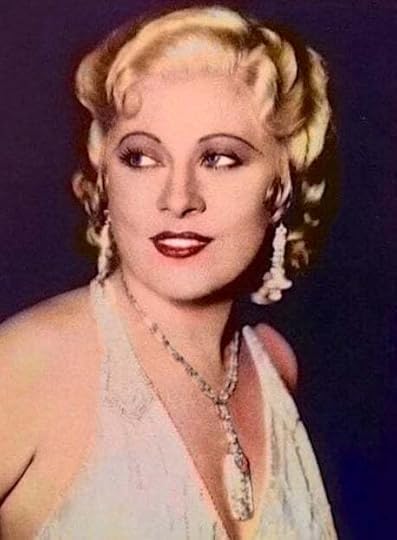
Mae West: The Surprisingly Literary Star of Stage & Screen
. . . . . . . . . .
“I’ll try anything once, twice if I like it, three times to make sure.”
. . . . . . . . . .
“I’m single because I was born that way.”
. . . . . . . . . .
“Good girls go to heaven, bad girls go everywhere.”
. . . . . . . . . .
“I’m no model lady. A model’s just an imitation of the real thing.”
. . . . . . . . . .
“Ladies who play with fire must remember that smoke gets in their eyes.”
. . . . . . . . . .
“A dame that knows the ropes isn’t likely to get tied up.”
. . . . . . . . . .
“Marriage is a fine institution, but I’m not ready for an institution.”
. . . . . . . . . .
“It’s not the men in your life that matters, it’s the life in your men.”
. . . . . . . . . .
“Discarded lovers should be given a second chance, but with somebody else.”
. . . . . . . . . .
“Sex is an emotion in motion.”
. . . . . . . . . .
“I never said it would be easy, I only said it would be worth it.”
. . . . . . . . . .
“Cultivate your curves — they may be dangerous but they won’t be avoided.”
. . . . . . . . . .
“Those who are easily shocked should be shocked more often.”
. . . . . . . . . .
“Too much of a good thing can be wonderful!”
. . . . . . . . . .
“I never worry about diets. The only carrots that interest me are the number you get in a diamond.”
. . . . . . . . . .
“It is better to be looked over than overlooked.”
. . . . . . . . . .
“I used to be Snow White, but I drifted.”
. . . . . . . . . .
“Anything worth doing is worth doing slowly.”
. . . . . . . . . .
“Don’t keep a man guessing too long — he’s sure to find the answer somewhere else”
. . . . . . . . . .
“You are never too old to become younger!”
. . . . . . . . . .
“Love thy neighbor — and if he happens to be tall, debonair and devastating, it will be that much easier.”
. . . . . . . . . .
“Women like a man with a past, but they prefer a man with a present.”
. . . . . . . . . .
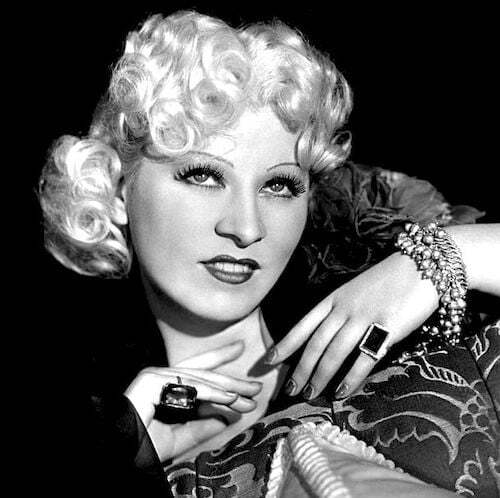
. . . . . . . . . .
“Look your best — who said love is blind? ”
. . . . . . . . . .
“His mother should have thrown him away and kept the stork.”
. . . . . . . . . .
“A woman in love can’t be reasonable — or she probably wouldn’t be in love.”
. . . . . . . . . .
“To err is human — but it feels divine.”
. . . . . . . . . .
“I have found men who didn’t know how to kiss. I’ve always found time to teach them.”
. . . . . . . . . .
“If a little is great, and a lot is better, then way too much is just about right!”
. . . . . . . . . .
“Men are my hobby, if I ever got married I’d have to give it up.”
. . . . . . . . . .
“Getting married is like trading in the adoration of many for the sarcasm of one.”
. . . . . . . . . .
“When women go wrong, men go right after them.”
. . . . . . . . . .
“Good women are no fun … The only good woman I can recall in history was Betsy Ross. And all she ever made was a flag.”
. . . . . . . . . .
“I’ve no time for broads who want to rule the world alone. Without men, who’d do up the zipper on the back of your dress? ”
. . . . . . . . . .
“Love conquers all things except poverty and toothache.”
. . . . . . . . . .
“I never loved another person the way I loved myself.”
. . . . . . . . . .
“She’s the kind of girl who climbed the ladder of success wrong by wrong.”
. . . . . . . . . .
“JUDGE: Are you trying to show contempt for this court?
MAE WEST: I was doin’ my best to hide it.”
. . . . . . . . . .
“Women with pasts interest men because they hope history will repeat itself.”
. . . . . . . . . .
“I only read biographies, metaphysics and psychology. I can dream up my own fiction.”
. . . . . . . . . .
“I’m a woman of very few words, but lots of action.”
. . . . . . . . . .
“An ounce of performance is worth pounds of promises.”
. . . . . . . . . .
“A man’s kiss is his signature.”
. . . . . . . . . .
“Everyone has the right to run his own life — even if you’re heading for a crash. What I’m against is blind flying.”
. . . . . . . . . .
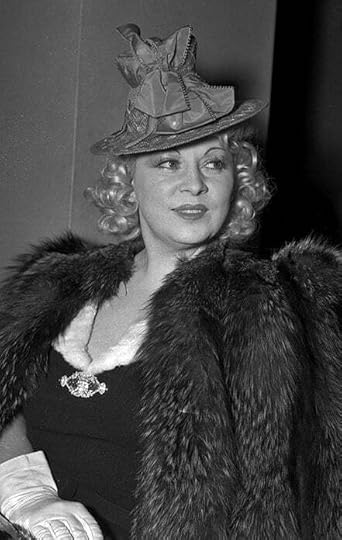
. . . . . . . . . .
“Love isn’t an emotion or an instinct — it’s an art.”
. . . . . . . . . .
“I’ve been in more laps than a napkin.”
. . . . . . . . . .
“I see you’re a man with ideals. I better be going before you’ve still got them.”
. . . . . . . . . .
“It isn’t what I do, but how I do it. It isn’t what I say, but how I say it, and how I look when I do it and say it.”
. . . . . . . . . .
“I saw what a mess a lot of people could make of their lives when they’re smitten. Some of them go temporarily insane. They find a person who they think holds the key to their happiness — the only key to their happiness … My work has always been my greatest happiness.”
. . . . . . . . . .
“A hard man is good to find.”
. . . . . . . . . .
“Goodness, what beautiful diamonds!” “Goodness had nothing to do with it.”
. . . . . . . . . .
“Ten men waiting for me at the door? Send one of them home, I’m tired.”
. . . . . . . . . .
“If I had known I was going to live this long, I would have taken better care of myself.”
. . . . . . . . . .
“Men are all alike — except the one you’ve met who’s different.”
. . . . . . . . . .
“I’ve been rich and I’ve been poor, and rich is better.”
. . . . . . . . . .
“I only like two kinds of men, domestic and imported.”
. . . . . . . . . .
“What’s the good of resisting temptation? There’ll always be more.”
. . . . . . . . . .
“Sex with love is the greatest thing in life. But sex without love — that’s not so bad either.”
. . . . . . . . . .
“Gentlemen prefer blondes, but who says blondes prefer gentlemen?”
. . . . . . . . . .
“You only live once, but if you do it right, once is enough”
More about Mae West
Mae West biography Mae West: Dirty Blonde (American Masters, PBS)The Best of Mae West (film clip compilation)The post 65 Witty, Bawdy Mae West Quotes appeared first on Literary Ladies Guide.
July 17, 2024
“Fifteen Bucolic Poems” by Edith Sitwell (1920
Dame Edith Sitwell (1887 – 1964), the British poet, literary critic, and famous eccentric, began publishing her poetry in 1913. With a modernist edge, some of it inscrutably abstract, some even set to music and sound.
Because of her dramatic self-presentation and manner of dress, she was sometimes criticized as a dilettante, but overall, her literary legacy remained intact and has grown over the years. Her poetry is praised for its craftsmanship and attention to technique.
Mother and Other Poems (1915) was her first published collection, followed by Clown’s Houses (1915). The following poems comprise the section titled “Fifteen Bucolic Poems” from her third collection, The Wooden Pegasus (1920). This book and its poems are in the public domain.
. . . . . . . . . . .
I
WHAT THE GOOSEGIRL SAID ABOUT THE DEAN
TURN again, turn again,
Goose Clothilda, Goosie Jane!
The wooden waves of people creak
From houses built with coloured straws
Of heat; Dean Pappus’ long nose snores—
Harsh as a hautbois, marshy-weak.
The wooden waves of people creak
Through the fields all water-sleek;
And in among the straws of light
Those bumpkin hautbois-sounds take flight,
Whence he lies snoring like the moon,
Clownish-white all afternoon,
Beneath the trees’ arsenical
Harsh wood-wind tunes. Heretical—
(Blown like the wind’s mane
Creaking woodenly again)
His wandering thoughts escape like geese,
Till he, their gooseherd, sets up chase,
And clouds of wool join the bright race
For scattered old simplicities.
. . . . . . . . . . .
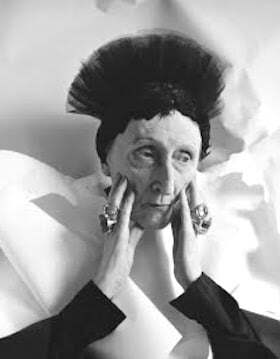
Learn more about Edith Sitwell
. . . . . . . . . .
II
NOAH
NOAH, through green waters slipping sliding like a long sleek eel,
Slithered up Mount Ararat and climbed into the Ark,—
Slipping with his long dank hair; and sliding slyly in his barque,
Pushed it slowly in a wholly glassy creek until we feel
Pink crags tremble under us and wondrous clear waters run
Over Shem and Ham and Japhet, moving with their long sleek daughters,
Swift as fishes rainbow-coloured darting under morning waters….
Burning seraph beasts sing clearly to the young flamingo Sun.
Note.—Thanks due to Helen Rootham for her earnest collaboration in this poem.
. . . . . . . . . . .
III
THE GIRL WITH THE LINT-WHITE LOCKS
THE bright-striped wooden fields are edged
With noisy cock’s crow trees, scarce fledged—
The trees that spin like tops, all weathers,
Like strange birds ruffling glassy feathers.
My hair is white as flocks of geese,
And water hisses out of this;
And when the late sun burns my cheek
Till it is pink as apples sleek,
I wander in the fields and know
Why kings do squander pennies so—
Lest they at last should weight their eyes!
But beggars’ ragged minds, more wise,
Know without flesh we cannot see—
And so they hoard stupidity
(The dull ancestral memory
That is the only property).
They laugh to see the spring fields edged
With noisy cock’s crow trees scarce fledged,
And flowers that grunt to feel their eyes
Made clear with sight’s finalities.
. . . . . . . . . . .
IV
THE LADY WITH THE SEWING MACHINE
ACROSS the fields as green as spinach,
Cropped as close as Time to Greenwich,
Stands a high house; if at all,
Spring comes like a Paisley shawl—
Patternings meticulous
And youthfully ridiculous.
In each room the yellow sun
Shakes like a canary, run
On run, roulade, and watery trill—
Yellow, meaningless, and shrill.
Face as white as any clock’s,
Cased in parsley-dark curled locks,
All day long you sit and sew,
Stitch life down for fear it grow,
Stitch life down for fear we guess
At the hidden ugliness.
Dusty voice that throbs with heat,
Hoping with its steel-thin beat
To put stitches in my mind,
Make it tidy, make it kind;
You shall not! I’ll keep it free
Though you turn earth sky and sea
To a patchwork quilt to keep
Your mind snug and warm in sleep.
. . . . . . . . . . .
V
BY CANDLELIGHT
HOUSES red as flower of bean,
Flickering leaves and shadows lean!
Pantalone, like a parrot,
Sat and grumbled in the garret,
Sat and growled and grumbled till
Moon upon the window-sill,
Like a red geranium,
Scented his bald cranium.
Said Brighella, meaning well—
“Pack your box and—go to Hell!
Heat will cure your rheumatism.”
Silence crowned this optimism.
Not a sound and not a wail—
But the fire (lush leafy vale)
Watched the angry feathers fly.
Pantalone ’gan to cry
Could not, would not, pack his box.
Shadows (curtseying hens and cocks)
Pecking in the attic gloom,
Tried to smother his tail-plume….
Till a cock’s comb candle-flame,
Crowing loudly, died: Dawn came.
. . . . . . . . . . .
VI
SERENADE
THE tremulous gold of stars within your hair
Are yellow bees flown from the hive of night,
Finding the blossom of your eyes more fair
Than all the pale flowers folded from the light.
Then, Sweet, awake, and ope your dreaming eyes
Ere those bright bees have flown and darkness dies.
. . . . . . . . . . .
VII
CLOWNS’ HOUSES
BENEATH the flat and paper sky
The sun, a demon’s eye,
Glowed through the air, that mask of glass;
All wand’ring sounds that pass
Seemed out of tune, as if the light
Were fiddle-strings pulled tight.
The market square with spire and bell
Clanged out the hour in Hell.
The busy chatter of the heat
Shrilled like a parokeet;
And shuddering at the noonday light
The dust lay dead and white
As powder on a mummy’s face,
Or fawned with simian grace
Round booths with many a hard bright toy
And wooden brittle joy:
The cap and bells of Time the Clown
That, jangling, whistled down
Young cherubs hidden in the guise
Of every bird that flies;
And star-bright masks for youth to wear,
Lest any dream that fare
—Bright pilgrim—past our ken, should see
Hints of Reality.
Upon the sharp-set grass, shrill-green,
Tall trees like rattles lean,
And jangle sharp and dizzily;
But when night falls they sigh
Till Pierrot moon steals slyly in,
His face more white than sin,
Black-masked, and with cool touch lays bare
Each cherry, plum, and pear.
Then underneath the veilèd eyes
Of houses, darkness lies,—
Tall houses; like a hopeless prayer
They cleave the sly dumb air.
Blind are those houses, paper-thin;
Old shadows hid therein,
With sly and crazy movements creep
Like marionettes, and weep.
Tall windows show Infinity;
And, hard reality,
The candles weep and pry and dance
Like lives mocked at by Chance.
The rooms are vast as Sleep within:
When once I ventured in,
Chill Silence, like a surging sea,
Slowly enveloped me.
. . . . . . . . . . .
VIII
THE SATYR IN THE PERIWIG
THE Satyr Scarabombadon
Pulled periwig and breeches on:
“Grown old and stiff, this modern dress
Adds monstrously to my distress;
The gout within a hoofen heel
Is very hard to bear; I feel
When crushed into a buckled shoe
The twinge will be redoubled, too.
And when I walk in gardens green
And, weeping, think on what has been,
Then wipe one eye,—the other sees
The plums and cherries on the trees.
Small bird-quick women pass me by
With sleeves that flutter airily,
And baskets blazing like a fire
With laughing fruits of my desire;
Plums sunburnt as the King of Spain,
Gold-cheeked as any Nubian,
With strawberries all goldy-freckled,
Pears fat as thrushes and as speckled …
Pursue them?… Yes, and squeeze a tear:
‘Please spare poor Satyr one, my dear.’
‘Be off, sir; go and steal your own!’
—Alas, poor Scarabombadon,
They’d rend his ruffles, stretch a twig,
Tear off a satyr’s periwig!”
. . . . . . . . . . .
IX
THE MUSLIN GOWN
WITH spectacles that flash,
Striped foolscap hung with gold
And silver bells that clash,
(Bright rhetoric and cold),
In owl-dark garments goes the Rain,
Dull pedagogue, again.
And in my orchard wood
Small song-birds flock and fly,
Like cherubs brown and good,
When through the trees go I
Knee-deep within the dark-leaved sorrel.
Cherries red as bells of coral
Ring to see me come—
I, with my fruit-dark hair
As dark as any plum,
My summer gown as white as air
And frilled as any quick bird’s there.
But oh, what shall I do?
Old Owl-wing’s back from town—
He’s skipping through dark trees: I know
He hates my summer gown!
. . . . . . . . . . .
X
MISS NETTYBUN AND THE SATYR’S CHILD
AS underneath the trees I pass
Through emerald shade on hot soft grass,
Petunia faces, glowing-hued
With heat, cast shadows hard and crude—
Green-velvety as leaves, and small
Fine hairs like grass pierce through them all.
But these are all asleep—asleep,
As through the schoolroom door I creep
In search of you, for you evade
All the advances I have made.
Come, Horace, you must take my hand.
This sulking state I will not stand!
But you shall feed on strawberry jam
At tea-time, if you cease to slam
The doors that open from our sense—
Through which I slipped to drag you hence!
. . . . . . . . . . .
XI
QUEEN VENUS AND THE CHOIR-BOY
(To Naomi Royde Smith)
THE apples grow like silver trumps
That red-cheeked fair-haired angels blow—
So clear their juice; on trees in clumps,
Feathered as any bird, they grow.
A lady stood amid those crops—
Her voice was like a blue or pink
Glass window full of lollipops;
Her words were very strange, I think:
“Prince Paris, too, a fair-haired boy
Plucked me an apple from dark trees;
Since when their smoothness makes my joy;
If you will pluck me one of these
I’ll kiss you like a golden wind
As clear as any apples be.”
And now she haunts my singing mind—
And oh, she will not set me free.
. . . . . . . . . . .
XII
THE APE SEES THE FAT WOMAN
AMONG the dark and brilliant leaves,
Where flowers seem tinsel firework-sheaves,
Blond barley-sugar children stare
Through shining apple-trees, and there
A lady like a golden wind
Whose hair like apples tumbles kind,
And whose bright name, so I believe,
Is sometimes Venus, sometimes Eve,
Stands, her face furrowed like my own
With thoughts wherefrom strange seeds are sown,
Whence, long since, stars for bright flowers grew
Like periwinkles pink and blue,
(Queer impulses of bestial kind,
Flesh indivisible from mind.)
I, painted like the wooden sun,
Must hand-in-hand with angels run—
The tinsel angels of the booth
That lead poor yokels to the truth
Through raucous jokes, till we can see
That narrow long Eternity
Is but the whip’s lash o’er our eyes—
Spurring to new vitalities.
. . . . . . . . . . .
XIII
THE APE WATCHES “AUNT SALLY”
THE apples are an angel’s meat,
The shining dark leaves make clear-sweet
The juice; green wooden fruits alway
Drop on these flowers as white as day—
Clear angel-face on hairy stalk;
(Soul grown from flesh, an ape’s young talk.)
And in this green and lovely ground
The Fair, world-like, turns round and round,
And bumpkins throw their pence to shed
Aunt Sally’s crude-striped wooden head.
I do not care if men should throw
Round sun and moon to make me go,
(As bright as gold and silver pence) …
They cannot drive their own blood hence!
. . . . . . . . . . .
XIV
SPRINGING JACK
GREEN wooden leaves clap light away,
Severely practical, as they
Shelter the children, candy-pale.
The chestnut-candles flicker, fail….
The showman’s face is cubed clear as
The shapes reflected in a glass
Of water—(glog, glut, a ghost’s speech
Fumbling for space from each to each).
The fusty showman fumbles, must
Fit in a particle of dust
The universe, for fear it gain
Its freedom from my box of brain.
Yet dust bears seeds that grow to grace
Behind my crude-striped wooden face
As I, a puppet tinsel-pink,
Leap on my springs, learn how to think,
Then like the trembling golden stalk
Of some long-petalled star, I walk
Through the dark heavens until dew
Falls on my eyes and sense thrills through.
. . . . . . . . . . .
XV
“TOURNEZ, TOURNEZ, BONS CHEVAUX DE BOIS”
TURN, turn again,
Ape’s blood in each vein.
The people that pass
Seem castles of glass,
The old and the good,
Giraffes of blue wood;
The soldier, the nurse,
Wooden face and a curse,
Are shadowed with plumage
Like birds by the gloomage.
Blond hair like a clown’s,
The music floats, drowns
The creaking of ropes
The breaking of hopes.
The wheezing, the old,
Like harmoniums scold:
Go to Babylon, Rome,
The brain-cells called home,
The grave, New Jerusalem,
Wrinkled Methusalem:
From our floating hair
Derived the first fair
And queer inspiration
Of music (the nation
Of bright-plumed trees
And harpy-shrill breeze).
. . .
Turn, turn again,
Ape’s blood in each vein.
The post “Fifteen Bucolic Poems” by Edith Sitwell (1920 appeared first on Literary Ladies Guide.
Mae West, the Surprisingly Literary Star of Stage & Screen
The notorious stage and screen actress and playwright Mae West of “come up and see me some time” fame, was surprisingly literary minded. West was famous as an actress, but it’s far less known that she wrote all her own stage and screen roles, creating the wickedly witty vamp character she became identified with.
Despite her bad girl reputation, despite having been sentenced to ten days in prison for obscenity in her 1926 play Sex, and despite the equally provocative title of her 1927 play The Drag: A Homosexual Play in Three Acts, Mae West wasn’t as much a modern woman as she seemed. Of her 1928 play Diamond Lil West said:
“People have said that I must be bad myself because I played bad parts so well. They fail to credit me with intelligence and love for my art … Particularly now, with such things as ‘companionate marriage’ ideas floating around, is Diamond Lil timely. I don’t believe in it. I think it is nothing more than contracted prostitution. Marriage, love, and home should be kept sacred … I believe in the single standard for men and women.”
A self-created persona
In an interview in the July 4, 1928 issue of Variety, West emphasized her unique ability to maintain multiple current love affairs, if only in a fictional setting. People tend to forget that practically all the quotes for which she became (in) are all from fictional works that she wrote for her self-created persona to play.
“Diamond Lil has all my stuff in it … I only go into a play where I can be myself and strut my stuff. I know how I want to walk and talk, show off my figure and looks. I can bring one man after another into a play to revolve around me and no one else can. I have five men in love with me in ‘Diamond Lil’ and most authors can’t keep up one love interest,” said the star of the season’s $17,000 weekly freak riot at the Royale, New York.
. . . . . . . . . .

Mae in 1936
. . . . . . . . . .
An early example of her many wisecracks seeming to contradict the quote above comes from the play Sex, where the prostitute Margy is talking about a friend. “She had a guy she thought she was in love with and thought she needed and then she got wise. Now she’s married to an old guy, and she’s got a mansion up near Boston and a limousine and diamonds and everything she wants.”
West was famous for her limousine; another quote is, “If you’re trig and trim and straight and wiry you’ll travel in a slam-bang sports roadster, but if you’re curved and soft and elegant and grand, you’ll travel in a limousine.”
West’s “blonde bombshell” persona was just that: a front for a first-class stage and screen playwright, seriously underestimated as a writer, then and now.
. . . . . . . . . .

A revival of Mae West’s play, Sex, originally staged in 1926
. . . . . . . . . .
She had two plays in production in New York in 1928: Diamond Lil and Pleasure Man, which was prosecuted for a performance at the Biltmore Theater on October 1, 1928, for “unlawfully advertising, giving, presenting and participating in an obscene, indecent, immoral and impure drama, play, exhibition, show and entertainment.”
The prosecution claimed that the play dealt with “sex, degeneracy, and sex perversion” arguing that West and her collaborators “did unlawfully, wickedly and scandalously, for lucre and gain, produce, present and exhibit and display the said exhibition show and entertainment to the site and view of divers and many people, all to the great offense of public decency.”
The 1928 prosecution was especially incensed by the presence of openly gay actors and “the speeches, manners and obscene jokes of a large number of male degenerates.”
West’s empathy with and encouragement of gay actors made her an early icon of the gay scene. Much later West said, “They were all crazy about me and my costumes. They were the first ones to imitate me in my presence.”
West even brought the gay actors from The Drag home to meet her mother. “They’d do her hair and nails and she’d have a great time.”
. . . . . . . . . .

Mae in 1940
. . . . . . . . . .
At the time of the apotheosis of the flat-chested, bobbed-haired, flat-heeled flapper, West was the anti-flapper personified, famous as much for her bust and figure-accentuating dresses as for her wisecracks – “I look pretty buxom and blonde, don’t I? Well, believe me, I’m the kind gentlemen prefer.”
West is referring to Gentlemen Prefer Blondes by Anita Loos, which had been published in 1925 to great acclaim. But despite her love for her gay friends, West blamed gay designers for the flat-chested flapper look she so disapproved of. “God gave women their curves – effeminate dressmakers took them away by designing garments which could be worn only by women shaped like scarecrows.”
It’s important to remember just how outrageous the association with gay men, who could be jailed for homosexual activities, was considered in 1928, the year Radclyffe Hall’s The Well of Loneliness was banned in England.
Mae West was presumably not surprised and probably not upset by the publicity her plays gained from being prosecuted – she was clearly courting prosecution and controversy with her outrageous titles.
Being “Banned in Boston” could be lucrative; being banned in New York was probably even better in terms of revenue for a book, film or play. In naming her works so provocatively, West was only taking to the limit a piece of advice on finding a title for a film given by silent movie actress Agnes Smith in the April 1928 issue of the movie magazine Photoplay.
“Maybe it is an Art; maybe it is a superstition. Anyway, whatever it is, motion picture magnates piously believe that by observing the following rules in the main title, almost any picture will lure the public to the box-office:
All box-office titles should hint at a sex situation, a sex struggle, or a sex indiscretion.The word “love” in a title is guaranteed to make men, women, and children part with their quarters. Next in importance to the word “love” are such luscious words as passion, heart, kisses, woman, scandal, devil, marriage, flesh, and sin.”More about Mae West
Mae West biography Mae West: Dirty Blonde (American Masters, PBS)The Best of Mae West (film clip compilation). . . . . . . . .
Contributed by Francis Booth, the author of several books on twentieth-century culture: Amongst Those Left: The British Experimental Novel 1940-1960 (published by Dalkey Archive); Everybody I Can Think of Ever: Meetings That Made the Avant-Garde; Girls in Bloom: Coming of Age in the Mid-Twentieth Century Woman’s Novel; Text Acts: Twentieth-Century Literary Eroticism; Comrades in Art: Revolutionary Art in America 1926-1938; High Collars & Monocles: 1920s Novels by British Female Couples; and A Girl Named Vera Can Never Tell a Lie: The Fiction of Vera Caspary.
Francis has also published several novels: The Code 17 series, set in the Swinging London of the 1960s and featuring aristocratic spy Lady Laura Summers; Young adult fantasy series The Watchers; and Young Adult fantasy novel Mirror Mirror. Francis lives on the South Coast of England.
Images in this article courtesy of Wikimedia Commons
The post Mae West, the Surprisingly Literary Star of Stage & Screen appeared first on Literary Ladies Guide.
July 11, 2024
Dame Edith Sitwell, Writer, Poet, and Eccentric Extraordinaire
Dame Edith Sitwell (September 7, 1887 – December 9, 1964) was a British poet considered one of the first of the avant-garde movement. She had an enormous influence on literature and was also known for her eccentric demeanor, bon mots, and rather pronounced, if sarcastic, opinions.
As Elizabeth Bowen once said, she was “a high altar on the move.” Photo at right by Cecil Beaton.
An unhappy childhood
In many ways Edith was the quintessential poor little rich girl. Born in Scarborough, England, her aristocratic parents, Sir George Sitwell and his wife, Lady Ida Denison, lived in the family home in Derbyshire, Renishaw. The family fortune came from land and ironmaking.
Unhappily for their young daughter, the Sitwells were cold and distant parents; some even guessed that Lady Ida, a volatile woman, may not have wanted her. It didn’t help that the pale and gangly child had a beaked nose and crooked back, her parents therefore keeping her in braces for most of her early years.
Edith must have been a precocious and bright child: At four years of age, she told her parents she wanted to be a genius when she grew up. She never did forgive her mother for her terrible childhood, and later, didn’t bother to attend her funeral.
She was very close to her two brothers, Osbert Sitwell and Sacheverell Sitwell, both of whom also became famous writers. For many years her closest companion, with whom she later lived in London and Paris, was her governess Helen Rootham, herself a poet.
. . . . . . . . . .
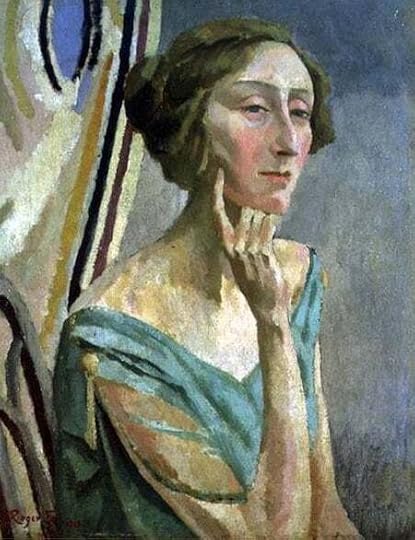
A portrait of Edith by Bloomsbury artist Roger Fry, 1918
. . . . . . . . . .
In 1915 Edith published her first poetry collection Mother and Other Poems. A year later she and her brothers were putting together the poetry anthology Wheels, a showcase for fellow modernist poets, which had six issues and was a reaction to the sentimentality of the Georgian movement. The Sitwell siblings were now known as “the alternative Bloomsbury” and running in the same circles as William Butler Yeats and T. S. Eliot.
What made Edith’s poetry most interesting was that she took everyday topics and gave them a modern slant; she was a matador of words. One critic said she “tilted Romanticism on its head.”Her themes were life, death, and the human condition.
Her work can be divided into two periods, the early pieces were often nonsensical and playful, the later more serious. The poet Charles Baudelaire was a great influence Her poems had a certain rhythm, and many were set to music by composers such as William Walton and Benjamin Britten for performances.
. . . . . . . . . . .
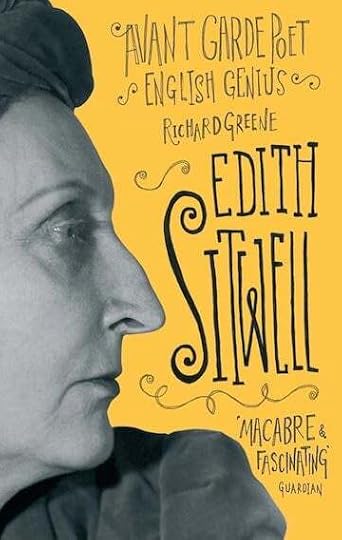
. . . . . . . . . . .
Thoughts on poetry and major achievementsEdith Sitwell explained her attitude towards sound in poetry in her autobiography, Taken Care Of (1965):
“Rhythm is one of the principal translators between dream and reality. Rhythm might be described as, to the world of sound, what light is to the world of sight. It shapes and gives new meaning. Rhythm was described by Schopenhauer as melody deprived of its pitch.”
Her masterpiece is considered the poem Still Falls the Rain which was written during the London Blitz of World War II. It intertwines the suffering of the people with the suffering of Christ and ends on an element of hope. (.)
The body of work Edith left behind was considerable: Twenty-one poetry collections; books on Queen Victoria, Elizabeth I, and Alexander Pope; a novel; an autobiography; and a book on English eccentrics, among others. She was made a Dame of the British Empire in 1954.
Richard Greene, well-known poet, biographer, and a professor of literature and creative writing wrote at the University of Toronto wrote two books on Edith Sitwell which are highly respected: Edith Sitwell: Avant Garde Poet, English Genius and Selected Letters of Edith Sitwell (editor).
When I spoke to him, he mentioned he believes that Edith Sitwell’s work was often criticized because she was a “soft target” and was writing in the days you could “dismiss a woman poet.” After all, no one was going to take on titans like William Butler Yeats or T.S. Eliot.
. . . . . . . . . .
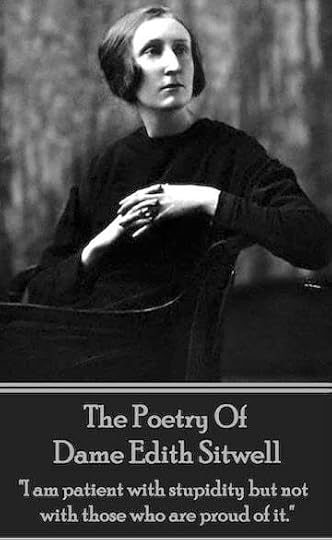
. . . . . . . . . .
Eccentricities and idiosyncrasiesIt’s impossible to write about Dame Edith without mentioning her idiosyncrasies. Her dress was flamboyant and somewhat Elizabethan: brocaded gowns; clunky jewelry (now displayed in The Victoria and Albert Museum); velvet turbans; and capes. With her chalky face, hawk nose, and thinly lined eyebrows, she cut quite a figure and proudly so.
In her words, “I am not eccentric. It’s just that I am more alive than most people. I am an unpopular electric eel set in a pond of goldfish.”
She never married and seemed to have a penchant for unavailable men who were mostly homosexual, including the poet Siegfried Sassoon, and the painter Pavel Tchelitchew.
To her credit, she championed Dylan Thomas and Denton Welch when they were young writers
With her flair for drama, she was also infamous for the feuds she had with luminaries like Robert Graves, D.H. Lawrence, and Wyndham Lewis.
Noel Coward once wrote a sketch called The Swiss Family Whittlebot which made fun of the Sitwell siblings and caused hostilities for years. Perhaps this was why she developed such a rapier wit: It was to protect herself, or as Prof. Greene once explained, “a way of keeping human suffering at bay.”
After Dame Edith’s death in 1964, times and literary tastes changed, and she began to slip into oblivion. Thankfully, Professor Greene said her reputation is starting to recover: her work is showing up in more anthologies and she is “spoken of more seriously” these days.
Perhaps Katherine Anne Porter said it best when describing Dame Edith’s work as “the true flowering branch springing fresh from the old, unkillable roots of English poetry, with the range, variety, depth, fearlessness, the passion and elegance of great art.”
“The Innocent Spring” (1924) is one of Dame Edith’s loveliest poems:
The Innocent Spring
In the great gardens, after bright spring rain,
We find sweet innocence come once again,
White periwinkles, little pensionnaires
With muslin gowns and shy and candid airs,
That under saint-blue skies, with gold stars sown,
Hide their sweet innocence by spring winds blown,
From zephyr libertines that like Richelieu
And d’Orsay their gold-spangled kisses blew;
And lilies of the valley whose buds blonde and tight
Seem curls of little school-children that light
The priests’ procession, when on some saint’s day
Along the country paths they make their way;
Forget-me-nots, whose eyes of childish blue,
Gold-starred like heaven, speak of love still true;
And all the flowers that we call ‘dear heart’,
Who say their prayers, like children, then depart
Into the dark. Amid the dew’s bright beams
The summers airs, like Weber waltzes, fall
Round the first rose, who, flushed with her youth, seems
Like a young Princess dressed for her first ball.
Who knows what beauty ripens from dark mould
After the sad wind and winter’s cold?
But a small wind sighed, colder than the rose,
Blooming in desolation, ‘No one knows.’
Further reading and sourcesGreene, Richard, author of Edith Sitwell: Avant Garde Poet, English Genius. Great Britain: Virago, 2011.
Personal interview, June 25, 2024. Greene, Richard, ed. Selected Letters of Edith Sitwell. Great Britain: Virago, 1997.Poetry Foundation, Edith Sitwell .Edith Sitwell, British Poet, Encyclopedia Britannica, 1998-2024 (updates).Cooke, Rachel. Edith Sitwell: Avant Garde Poet, English Genius by Richard Greene – review. The Guardian. 2011.Staff, Harriet. After 30 Years, a new Edith Sitwell Biography– review of Richard Greene’s
Edith Sitwell: Avant Garde Poet, English Genius. Poetry Foundation website, 2011.Meyers, Jeffrey. Review of Edith Sitwell: Avant-Garde Poet, English Genius by Richard Green,
The Globe and Mail, May. 2011.
Contributed by Tyler Scott, who has been writing essays and articles since the early 1980s for various magazines and newspapers. In 2014 she published her novel The Excellent Advice of a Few Famous Painters. She lives in Blackstone, Virginia where she and her husband renovated a Queen Anne Revival house and enjoy small town life. Visit her at Pour the Coffee, Time to Write.
The post Dame Edith Sitwell, Writer, Poet, and Eccentric Extraordinaire appeared first on Literary Ladies Guide.
June 20, 2024
10 Lost Ladies of Literary Translation: A Tribute
Presented here are ten trailblazing women translators whose work proved groundbreaking, from the 16th to 20th centuries.
After being entirely forgotten or reduced to half a line in their husbands’ entries in many encyclopedias, women translators are now starting to be recognized in their own right. Shown at right, translator Matilda Mary Hays (standing) and a love interest, actress Charlotte Cushman, 1858.
. . . . . . . . . .
Margaret Tyler:From Religious Text to Fiction
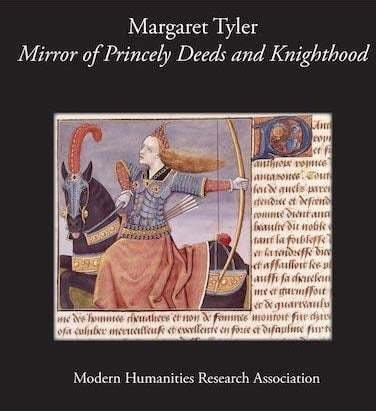
After being anonymous or hidden behind a male pseudonym, women translators began to sign their translations with their real names in the 16th century. It was a time when women were only supposed to translate religious texts to promote piety among other women.
Margaret Tyler (1540-1590) instead chose to translate a Spanish romance by Diego Ortúñez de Calahorra into English under the title The Mirrour of Princely Deeds and Knighthood (printed in 1578).
In her Letter to the reader, Tyler protested against the fact that profane content was deemed inappropriate for a woman, insisted on the seriousness and importance of literary work for women, and expressed the wish for women and men to be treated as equal rational beings.
While little is known about her, the letter of dedication introducing her translation was addressed to Lord Thomas Howard, so she might have been a servant in his aristocratic Catholic family.
The source of her knowledge of Spanish is unknown. We only know that to speak Spanish was valued by English merchants because of their economic ties to Spain, and that some merchants’ daughters and servants learned the language for this purpose.
. . . . . . . . . .
Giuseppa Barbapiccola:Advocate for Women’s Education
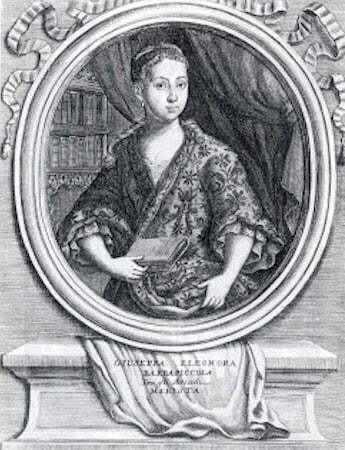
Giuseppa Eleanora Barbapiccola (1702 – 1740) was an Italian philosopher who translated Principles of Philosophy by French philosopher René Descartes. Her goal was not only to convey Descartes’ philosophy to an Italian audience but also to show that Descartes praised the female intellect and, in doing so, to inspire women to educate and empower themselves.
In the preface to her translation (1722), she also expressed her own ideas, writing that “Women should not be excluded from the study of the sciences, since their spirits are more elevated and they are not inferior to men in terms of the greatest virtues.”
Giuseppa defended the right to education for all women and also tried to persuade women to take the matter into their own hands and to educate themselves.
She asserted that the inherent nature of women – and the perception of them as the weaker sex – was not the cause of their ignorance. The cause of their ignorance was the lack of education or poor education because women have always had the capacity to learn. To this end, her translation included a history of women’s education and a history of philosophy.
. . . . . . . . . .
Anne Dacier:Translating the Ancient Greeks
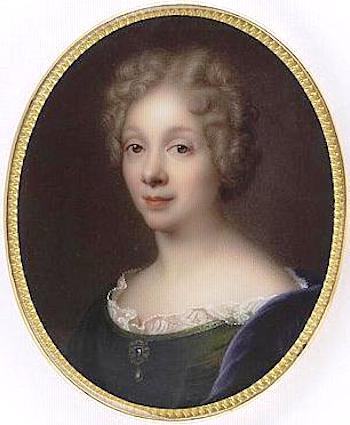
A French scholar, Anne le Fever Dacier (1654 – 1720) was taught Latin and Greek at a young age by her father Tanneguy Le Fèvre when they lived in Saumur, a town in central France. After her father’s death in 1672, she moved to Paris and worked with Pierre-Daniel Huet, a friend of her father who was in charge of a comprehensive edition of Latin classics named the Delphin Classics.
She produced new Latin editions of poets Publius Annius Florus, and historians Dictys Cretensis, Sextus Aurelius Victor and Eutropius. She also translated into French several works by Greek poets Anacreon and Sappho, and by Roman playwrights Plautus, Aristophanes and Terence.
Her major work was the prose translation of Greek epic poet Homer’s Iliad (completed in 1699) and Odyssey (completed in 1708). Her translations were praised by her contemporaries, including English poet Alexander Pope, who then translated Homer’s epic poems from French into English, with the English editions published in 1715-20 for Iliad and in 1725-26 for Odyssey. (To translate works from an existing translation instead of the original work was common at the time.)
Anne Dacier wrote an essay on Pope’s translation of Odyssey, which gained her some fame in England as well.
. . . . . . . . . .
Elizabeth Ashurst & Matilda Hays:Translating George Sand
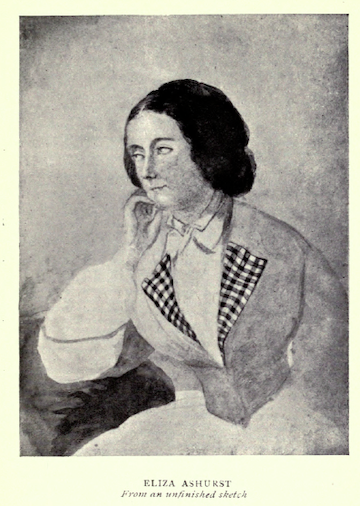
In the mid-19th century, Elizabeth Ann Ashurst (1813 – 1850, also known as Eliza Ann Bardonneu) an English radical activist, and Matilda Mary Hays (1820 – 1850), an English feminist novelist, immersed themselves in the novels of famed French novelist George Sand.
Fascinated by Sand’s independent lifestyle, her vision of free love and the political and social issues addressed in her books, they translated some of her novels into English for them to reach a wider audience.
Ashurst belonged to a family of radical activists who supported causes ranging from women’s suffrage to Risorgimento (Italian unification). She attended the World Anti-Slavery Convention in 1840 in London, with her father William Ashurst and her sister Matilda Ashurst, but was not allowed to speak since women were not considered full delegates.
Hays had already translated The Last Aldini by George Sand. She then met and befriended Ashurst. Together they translated Spiridion, Letters of a Traveller, The Master Mosaic-Workers and André.
Hays translated Fadette alone after the death of Elizabeth Ashurst in childbirth. The translations were mainly published in 1847, except for the translation of Spiridion, published in 1842, and the translation of Fadette, published in 1851.
Like George Sand, Matilda Hays was determined to use her writings to improve the condition of women. In her novel Helen Stanley (1846), she wrote that women couldn’t secure their financial and social future until “They teach their daughters to respect themselves to work for their daily bread, rather than prostitute their persons and hearts” by getting married.
She also co-founded the monthly English Woman’s Journal and was its editor from 1858 to 1864.
. . . . . . . . . .
Louise Swanton Belloc:English literary classics into French
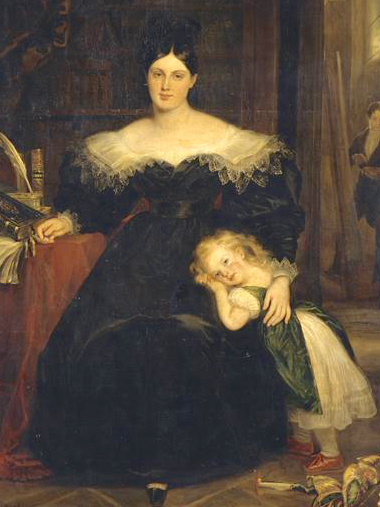
Louise Swanton Belloc (1796 – 1881), a French writer, translated English-language literary works into French. Born in La Rochelle, a seaport in western France, she received an education with a focus on English language and culture.
She advocated for women’s education, and contributed to the creation of the first circulating libraries. Her writings and translations introduced English literary works to a French audience. She wrote articles for the French journal Revue encyclopédique under the supervision of its founder and editor Marc-Antoine Jullien.
She befriended French writers Victor Hugo, Emile Souvestre and Alphonse de Lamartine. She also befriended English writer Charles Dickens, Anglo-Irish writer Maria Edgeworth, and American writer Harriet Beecher Stowe. She translated some of their works into French, including Harriet Beecher Stowe’s Uncle Tom’s Cabin.
She also translated Lord Byron’s memoirs, as well as books by Scottish writers Elizabeth Gaskell and Walter Scott, and Irish writers Oliver Goldsmith and Thomas Moore.
. . . . . . . . . .
Mary Howitt:German, Swedish, and Danish to English
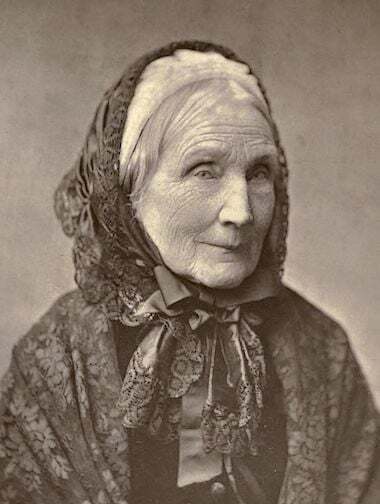
Mary Howitt (1799 – 1888), an English poet and writer, translated German, Swedish, and Danish literary works into English. Born in a Quaker family living in Gloucestershire, a county in southwestern England, she began writing verses at an early age, long before writing her famous poem The Spider and The Fly (1828).
She married fellow Quaker writer William Howitt in 1821, and began a lifelong career of joint authorship and travels with him, except during his Australian journey in 1851-54 when he tried to make a fortune there. They befriended many English literary figures such as novelists Charles Dickens and Elizabeth Gaskell, and poets Elizabeth Barrett Browning, William Wordsworth, and Dorothy Wordsworth.
When living in Heidelberg, Germany, in 1840, Howitt became acquainted with Scandinavian literature, and learned Swedish and Danish. She translated Swedish writer Fredrika Bremer’s novels, and her 18-volume translation (1842 – 63) helped introduce Bremer to English readers, including her ideas as a feminist reformer.
She translated Danish writer Hans Christian Andersen’s fairy tales from 1845 to 1847. She received a Silver Medal from the Literary Academy of Stockholm for conveying Scandinavian literature through translation.
. . . . . . . . . .
Anna Swanwick:Translating Goethe, Schiller & more
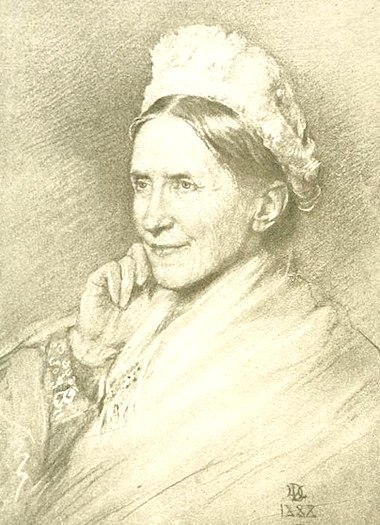
Anna Swanwick (1813 – 1899), an English feminist writer, translated German and Greek literary works into English. Born in Liverpool, England, she moved to Berlin, Germany, in 1839 to study German, Greek and Hebrew.
Back in England in 1843, she translated some works by German luminaries Goethe and Schiller, and published them as Selections from the Dramas of Goethe and Schiller (1843). She produced blank-verse translations of other works by Goethe in 1850, with a second edition in 1878. Her translation of Goethe’s Faust was highly praised, and republished several times.
Anna Swanwick also produced a blank-verse translation of Greek tragedian Aeschylus’ Trilogy (1865), followed by a translation of all his plays (1873). She was interested in many social issues of her day, especially the education of women and the working classes.
. . . . . . . . . .
Therese Albertine Luise Robinson:Multi-Lingual Translator
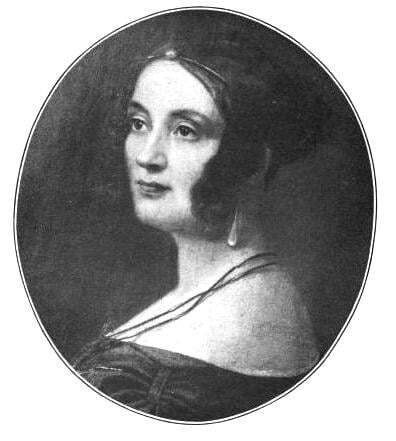
Therese Albertine Luise Robinson (1797 – 1870), a German-American writer and linguist, translated English and Serbian poetry and folk songs into German. Born in Germany, she first translated two novels by Scottish writer Walter Scott (Old Mortality and The Black Dwarf) in 1822 under the pseudonym Ernst Berthold.
She published a series of literary criticisms without signing them. She was reluctant to use her own name to publish her poetry and short stories, so she invented the pen name Talvj, formed with the initials of her birth name (Therese Albertine Louise von Jacob), to sign her collection of short stories Psyche (1825) and other works.
Her poems were later included in The Poets and Poetry of Europe (1845), a famous anthology of translated poems edited by American poet Henry Wadsworth Longfellow.
She learned Serbian after reading German philologist Jacob Grimm’s translations and comments on Serbian folk songs. She translated Serbian folk songs herself with the support and encouragement of the famous Johann Wolfgang von Goethe.
Published in 1826, her translation Volkslieder der Serben (Folk Songs of the Serbs) was praised by Goethe and the German literary world. After marrying American theologian Edward Robinson in 1828, she moved with him to Massachusetts in 1830.
She studied Native American languages, wrote a handbook, and translated into German the seminal article On Indian languages of North America written by American linguist John Pickering and published in Encyclopedia Americana in 1830-31. She also wrote a history of Slavic languages with her husband, published in 1834, with a second edition in 1850.
. . . . . . . . . .
Zenobia Camprubí:Translator of Rabindranath Tagore
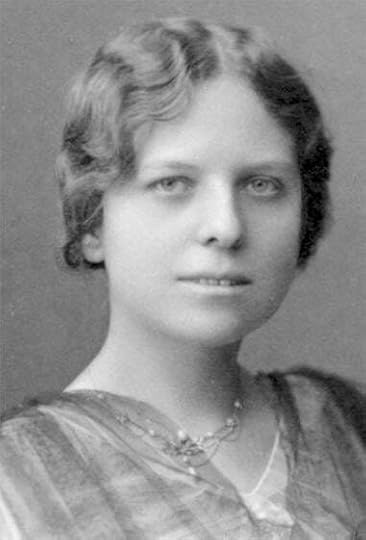
Zenobia Camprubí (1887– 1956), a Spanish feminist writer, translated English-language literary works into Spanish. Born in Malgrat de Mar, Spain, she met Spanish poet Juan Ramón Jiménez in 1913, and married him in 1916.
She moved to the United States, studied English literature at Columbia University, and lived in Cuba during the Spanish Civil War. She became a professor of Spanish literature at the University of Maryland, and spent her later years in Puerto Rico. She is considered a pioneer of Spanish feminism for actively promoting women in society.
Camprubí became the first translator of famed Bengali writer Rabindranath Tagore into Spanish, and translated 22 works (collections of poems, essays and plays) over the years. Tagore’s play The Post Office (translated by her) was performed in Spain in 1920, and his play The Elder Sister was performed the following year.
In addition to early works, Camprubí wrote several books, including the couple’s biography Juan Ramón y yo (1954), and Diario, her three-volume diary about her life in Cuba (1937-39), in the United States (1939-50) and in Puerto Rico (1951-56).
. . . . . . . . . .
Charlotte H. Bruner:Translator of Francophone African Women
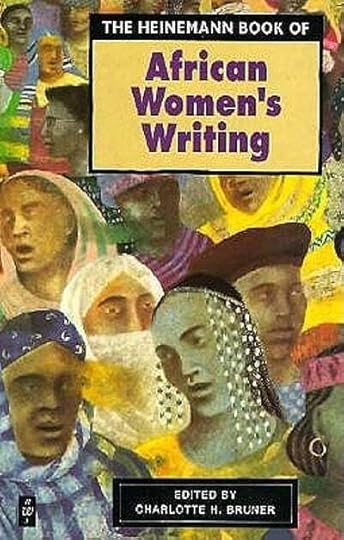
Charlotte H. Bruner (1917 – 1999), an American scholar, translated French-language literary works into English. Born in Urbana, Illinois, she received a Bachelor of Art from the University of Illinois in 1938, and a Master of Art from Colombia University in 1939. She was a professor of French at Iowa State College for three decades (1954-87).
She wrote extensively about African French-language women writers, and translated their works from French to English. She was a pioneer in both African studies and world literature at a time when American universities mainly taught European classics.
In the early 1970s, Bruner and her husband David Kincaid Bruner, spent one year in Africa interviewing these writers. Back home they aired their interviews in the series Talking Sticks. Charlotte Bruner then co-hosted First Person Feminine (1980-86), a weekly series in which she read and discussed world literature authored by women.
Charlotte Bruner was one of the editors of The Feminist Companion to Literature in English (1990). She edited two volumes of short stories by African women writers, The Heinemann Book of African Women’s Writings (1993) and Unwinding Threads (1994). She was inducted into the Iowa Women’s Hall of Fame in 1997.
Source: A history of translation in 150 portraits
Contributed by Marie Lebert. Reprinted by permission. Marie is a bilingual French-English translator. She has worked as a translator and/or librarian for international organizations and has written ebooks, articles and essays about translation and translators, ebooks, libraries and librarians, and medieval art. She holds a doctorate of linguistics (digital publishing) from the Sorbonne University, Paris, and a master of social science (society and culture) from the University of Caen, Normandy. Find more about women translators of the past at Marie Lebert.
. . . . . . . . . .
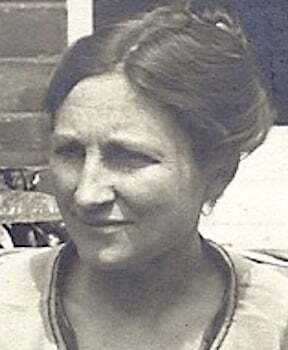
See also
Imagining Helen: The Life of Translator Helen Tracy Lowe-Porter
The post 10 Lost Ladies of Literary Translation: A Tribute appeared first on Literary Ladies Guide.
June 9, 2024
Jan Morris, “A Writer Who Travels”
Jan Morris (October 2, 1926 – November 2, 2020) was a Welsh author and historian, whose work spanned the genres of journalism, memoir, history, essays, articles, and novels.
As a writer, she is best known for her Pax Britannia trilogy (a social history of the British Empire) and her written portraits of cities including Trieste, Venice, Oxford, Hong Kong, and New York City. She is also famous for her transition from male to female in 1972, making her one of the first transgender public figures.
Early life and education
Jan Morris was born James Humphrey Morris in Clevedon, Somerset, and was the youngest of three sons. As is customary for persons who have transitioned (notwithstanding when the transition took place) Jan will be referred to with the pronouns she/her from here on.
Her mother Enid was a church organist, and her Welsh father Walter was an engineer. Both brothers went on to have careers in music – Gareth as a flautist and Christopher as an organist.
At the age of nine she attended Christ Church Cathedral School in Oxford as a chorister and went to Lancing College in Sussex. Color blindness prevented her from joining the navy during the war, and she enrolled in the 9th Queen’s Royal Lancers instead. For much of the 1940s she served as an intelligence officer in Palestine.
After the war, she studied English at Christ College, Oxford, then went on to work at a news agency in Cairo.
Journalism and first books
Morris covered the ascent of Everest in 1953, traveling with Edmund Hillary as far as Base Camp as a correspondent for The Times, and broke the news of the successful ascent just in time for it to reach London on Queen Elizabeth II’s coronation day.
It was one of many lucrative and ground-breaking assignments, though she left The Times after disagreeing with the editorial support of the Suez Crisis and joined the Manchester Guardian instead. There she alternated six months of working on the paper with six months of book research.
Morris’s first book, Coast to Coast (1956) was an account of a cross-U.S. journey funded by a twelve-month Commonwealth fellowship at the University of Chicago. Reviews were excellent, with the Guardian calling it “deeply evocative,” and contracts for the further books followed.
The first of Morris’s best-known books, a biography of Venice, was published in 1960. By her own admission, her approach to researching it was to “run about the city like a mad dog … [first] the law court … Then the market. And then the railway station.”
The book was successful enough for Morris to give up journalism and move towards writing books full-time. It was well-received both by the public and critics: Harold Nicolson called it “a highly intelligent portrait of an eccentric city … never soppy or sentimental … a very virile book.”
. . . . . . . . . .
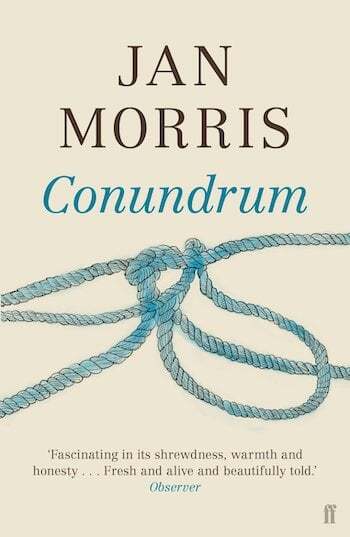
. . . . . . . . . .
Personal life and “Conundrum”Morris had married Elizabeth Tuckniss, a former Wren and tea planter’s daughter, in 1949. The couple had four children, Twm Morus, Henry Morris, Mark Morris and Suki Morus. Another daughter died in infancy.
Since she was a toddler, Morris had always been at odds with her male body. She recalled sitting at her mother’s piano at age three or four, realizing that “I had been born into the wrong body, and should really be a girl.”
At first she “cherished it as a secret” but for years felt a yearning “for I knew not what, as though there were a piece missing from my pattern…” By the 1960s she was effectively living a double life. “I was a member of two clubs in London,” she recalled, “one as a man and one as a woman, and I would sometimes change my identity in a taxi between the two.”
Elizabeth was supportive of Morris’s decision to undergo courses of hormone therapy, and then to have reassignment surgery in a Casablanca clinic in 1972. The surgery could have been performed in the U.K., but the law would have required that she and Elizabeth divorce, since two women could not be married at that time.
“I should have been terrified, but I wasn’t,” Jan Morris later said. “It was inevitable — I’d been heading there mentally all my life.”
Conundrum, published in 1974, was her account of the journey from male to female. In it, she detailed the clinic in Casablanca, the emotional journey and adjustment to life as a woman with a female partner, and the public reaction, which ranged from hostility to “kindly incomprehension” to acceptance.
She also expressed gratitude for Elizabeth’s support, saying that their marriage was a “living testimony…of love in its purest sense over everything else.” However, Morris’s daughter Suki would later claim that the transition brought a high cost to the rest of the family, in particular Elizabeth who “did not have a voice.”
Critics struggled with the book. A.N. Wilson admitted that he found it easy “to let a little bitchiness creep into one’s comments on Miss Morris’s most interesting book,” while fellow writer Rebecca West wrote that “now we are both women he mystifies me…[as a man] he had all the pleasures he wanted … she sounds not like a woman, but a man’s idea of a woman, and curiously enough, the idea of a man not nearly so intelligent as James Morris used to be…”
However, Morris’s most famous work, a trilogy on the social history of the British Empire, was also partly inspired by her exploration of gender identity.
“I thought how wonderful it would be if some Roman centurion in the last days of the empire had written not only a description of it, but also something about his own feelings. Then I thought, ‘here I am, on the collapsing frontiers of the British empire, why don’t I do it?’”
The result was the trio of books Pax Britannica (1968), Heaven’s Command (1973), and Farewell the Trumpets (1978). Later, Morris called the trilogy the “intellectual and artistic centre-piece of my life.”
. . . . . . . . . .
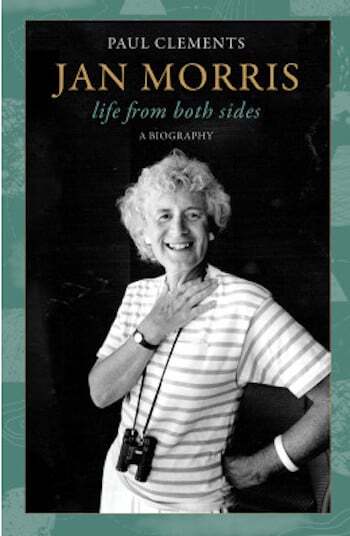
. . . . . . . . . .
“A writer who travels”Morris identified as Welsh, having always had an affinity with her father’s land, and became an ardent Welsh nationalist. She admitted being “emotionally in thrall to Welshness,” and after her reassignment surgery, the family moved to Plas Trepan in Llanystumdwy, Gwynedd, in northwest Wales.
By this point, she and Elizabeth had formally divorced, but they continued to live together as “sisters-in-law.” In 2008, when the law allowed them to do so, they registered a civil partnership at the Pwllheli registry office.
Morris continued to work and to travel. Writing had become a daily habit, and she often wrote upwards of 3000 words a day, more if a deadline was looming. Her single novel, Last Letters from Hav, was published in 1985 and shortlisted for the Booker Prize, while other later books included Fifty Years of Europe (1997), Lincoln: A Foreigner’s Quest (1999), and Trieste and the Meaning of Nowhere (2001).
Perhaps her most famous and well-read books were her biographies of cities, written in the same vein as her 1960 book on Venice. Places as diverse as Oxford, Trieste, Manhattan, and Hong Kong captured her attention, while in articles she wrote of Las Vegas (“the acrid smell of fun”), Aberdeen (“the brio of capitalism in the raw”) and the cathedral town of Wells (“the cathedral’s chief function was its own repair”). She also wrote about her beloved Wales in the book Wales: Epic Views of a Small Country.
She always rejected the term “travel writer,” insisting that she wrote books about place, “which are nothing to do with movement, but many more about people and about history.” She was, she insisted, a “writer who travels, not a travel writer.” That didn’t not stop her winning the Thomas Cook Travel Book Award for Outstanding Contribution to Travel Writing.
Her biographer, Derek Johns, wrote that “She involves the reader, while she remains unobtrusively present herself; who uses the particular to illustrate the general, and scatters grace notes here and there like benefactions. She is a watcher, usually alone, seldom lonely, alert to everything around her.”
. . . . . . . . . .
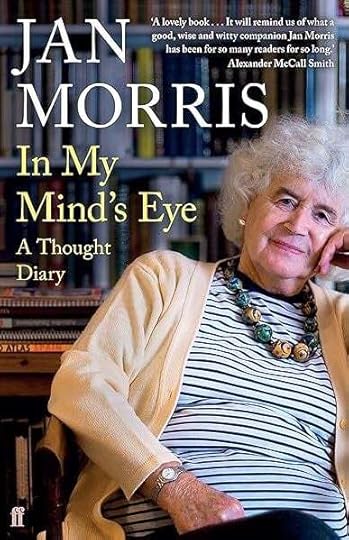
. . . . . . . . . .
Last books and legacy of Jan MorrisIn My Mind’s Eye (2018), a diary of memories written when Morris was ninety-one, was a BBC Radio 4 Book of the Week. Think Again, a collection of her diaries, was published just before her death in March 2020. Her final collection of essays, Allegorizings, was published posthumously in 2021.
Morris was elected to the Gorsedd of Bards in 1992 and made a CBE in 1999. She also received an honorary doctorate from the University of Glamorgan, was an Honorary Fellow of Christ Church College, Oxford, and a Fellow of the Royal Society of Literature. In 2005 she won the Golden Pen Award for outstanding contribution to literature.
Before her death, she and Elizabeth had a joint memorial stone made, intended for an islet in the river near Trefan Morys, which reads in both Welsh and English, “Here are two friends … At the end of one life.”
Jan Morris died on November 20, 2020, at the Ysbyty Bryn Beryl on the Llŷn Peninsula, Wales, and was survived by Elizabeth.
. . . . . . . . . . .
Contributed by Elodie Barnes. Elodie is a writer and editor with a serious case of wanderlust. Her short fiction has been widely published online and is included in the Best Small Fictions 2022 Anthology published by Sonder Press. She is Books & Creative Writing Editor at Lucy Writers Platform, she is also co-facilitating What the Water Gave Us, an Arts Council England-funded anthology of emerging women writers from migrant backgrounds. She is currently working on a collection of short stories, and when not writing can usually be found planning the next trip abroad, or daydreaming her way back to 1920s Paris. Find her online at Elodie Rose Barnes.
Further reading and sources
Jan Morris’s extensive bibliography of travel writing, essays, memoirsJan Morris: Life From Both Sides by Paul Clements, Scribe UK, 2022Conundrum by Jan Morris, Faber & Faber, reissued 2018In My Mind’s Eye: A Thought Diary by Jan Morris, Faber & Faber, 2019Trieste and the Meaning of Nowhere by Jan Morris, Faber & Faber, reissued 2022Venice by Jan Morris, Faber & Faber, reissued 1993Wales: Epic Views of a Small Country by Jan Morris, Penguin 2000A Writer’s World: Travels 1950-2000 by Jan Morris, Faber & Faber 2004Allegorizings by Jan Morris, Faber & Faber, 2021For younger readers: Jan Morrison, Travel Writer and Historian – an introduction.
The post Jan Morris, “A Writer Who Travels” appeared first on Literary Ladies Guide.



